|
Postcards from:
Big
Bear Lake
Hong Kong China
Bangkok
Thailand
Calcutta
India
Guwahati
India
Shillong
India
Kaziranga
India
Agartala
India
Dhaka
Bangladesh
Bodhgaya India
Varanasi India
Agra
India
New Delhi
India
Kathmandu Nepal
Bangkok Thailand
Xi'an China
Tianshui China
Lanzhou
China 1
Urumqi
China
1
Turpan
China
Korla China
Kuqa China
Aksu China
Kashgar
China
Urumqi China 2
Bishkek Kyrgyzstan
1
Cholponata Kyrgyzstan
Balykchy Kyrgyzstan
Bishkek Kyrgyzstan 2
Almaty Kazakhstan
1
Zharkent Kazakhstan
1
Almaty Kazakhstan
2
Zharkent Kazakhstan
2
Korghas China
Yining China
Urumqi China 3
Dunhuang China
Jiayuguan China
Zhang Ye China
Wu Wei China
Lanzhou China 2
Zhongwei China
Yinchuan China
Shanghai China
California USA
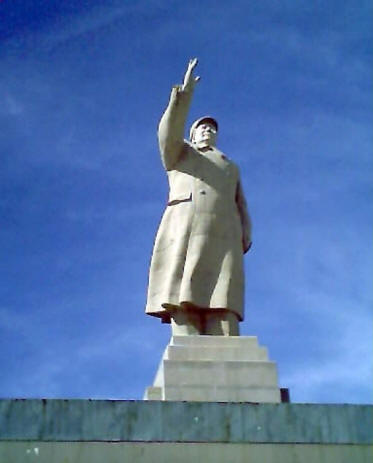
KASHGAR: Large statue of
Mao Zedong near the People's Square. In front of it is a large platform
review stand facing the square.
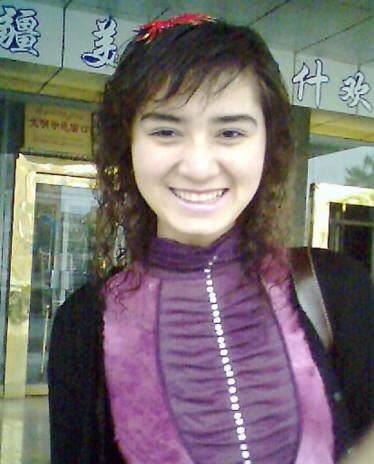
KASHGAR: Meet MariYam, a very friendly receptionist at the People's Hotel in
the very center of town who helped me buy my cheap ticket to Urumqi. email:
mari_juli@hotmail.com
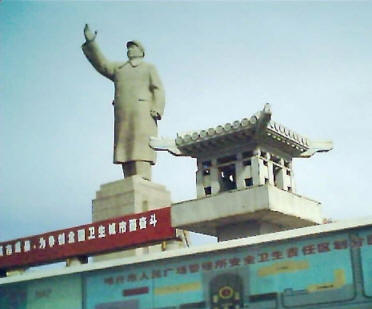
KASHGAR: Large statue of Mao Zedong near the People's Square.
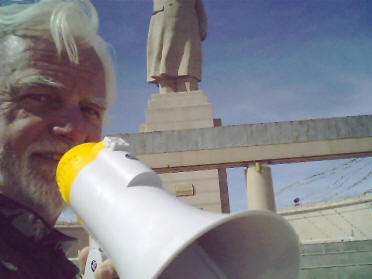
KASHGAR: Here I am standing in front of a large statue of Mao Zedong with my
megaphone ready to amplify every word the great leader might utter.
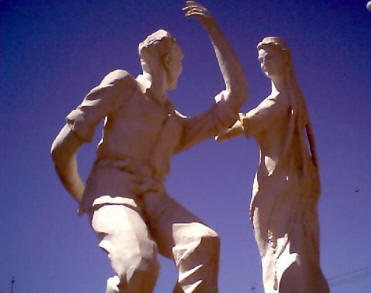
KASHGAR: One of the interesting sculptures on the grounds of the Qinibagh
Hotel where I stayed most of the time.
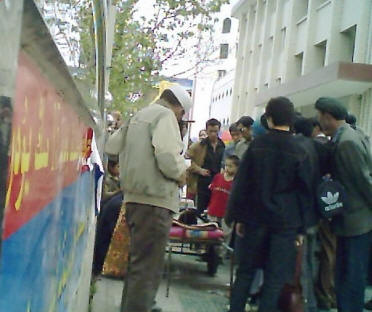
KASHGAR: A boy of about nine lay before an older bearded man who is feeding
him tiny spoonfuls of ice cream. A compassionate crowd hovers over the
scene. The boy is dying. The posters tell the story to all who pause long
enough to read them and add their small contribution to a box set up for
donations.

KASHGAR: A boy of about nine lay before the older bearded man who is feeding
him ice cream with a tiny spoon. A compassionate crowd hovers over the
scene. The boy is dying. I first saw this pitiful sight five days ago when I
first arrived.

KASHGAR: Colorful banners hang from buildings proclaiming store openings or
major promotions.
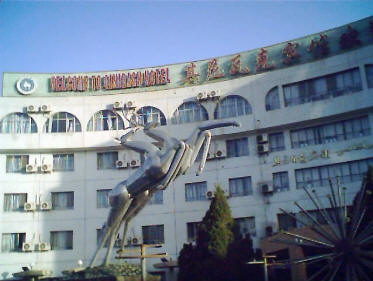
KASHGAR: Exterior of the older Qinibagh Hotel building.

KASHGAR: Part of the old city wall.
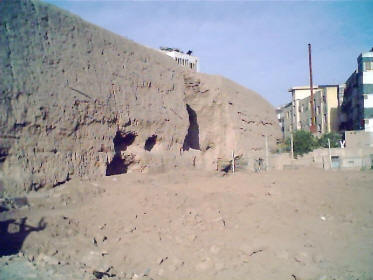
KASHGAR: Part of the old city wall not far from my hotel. It is 1600 years
old and made of rammed earth. Amazing it has not eroded away.
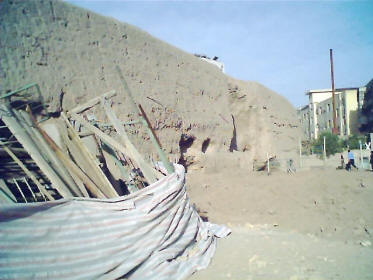
KASHGAR: Part of the old city wall. It is 1600 years old and made of rammed
earth. Amazing.
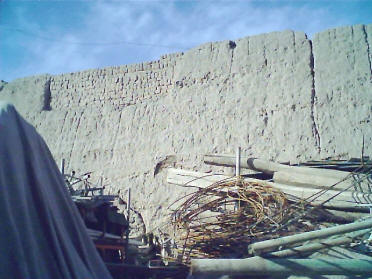
KASHGAR: Part of the old city wall sits next to piles of trash. It is 1600
years old and made of tamped earth. It is amazing it has lasted so long.
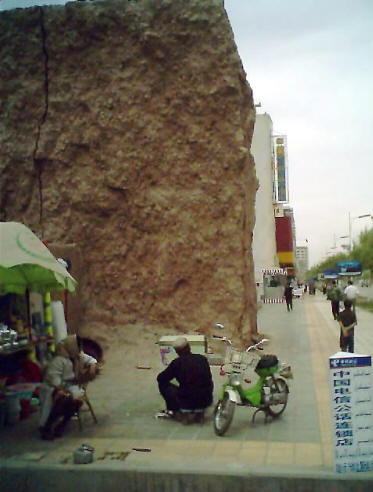
KASHGAR: The ancient wall seems to be standing in the way of modern
progress. So, parts of the old 1600 year old crumbling wall must go.

KASHGAR: The interesting building with the spiral staircase is located at
the junction of Jiefang Road and Seman Road.
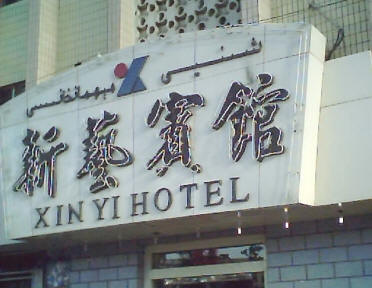
KASHGAR: This seemed like a strange name for a hotel located on Seman
Road... at least when pronounced in English: "Sin Ye." Later, a Chinese
friend explained the name actually means "New Art."
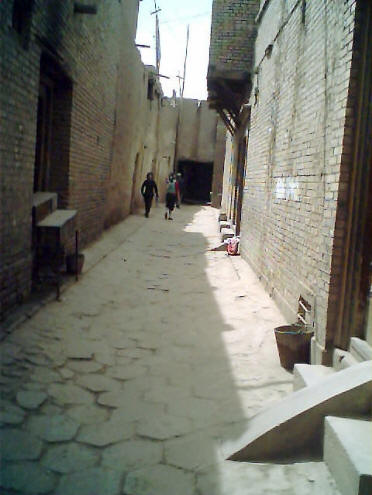
KASHGAR: Looking down one of the residential streets in the old Uyghur
section.
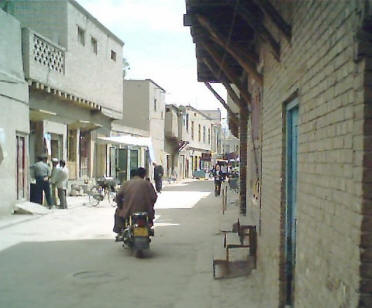
KASHGAR: Main street in an all Uyghur section of town. Donkey carts,
bicycles, motorcycles and a few cars wind their way through the narrow hard
packed dirt streets.
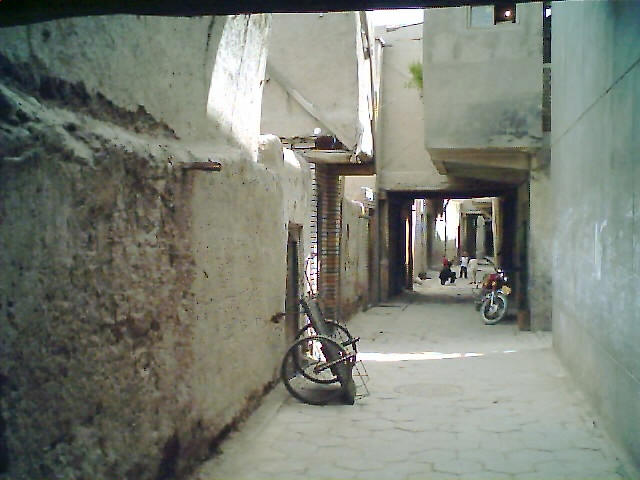
KASHGAR: Looking down one of the residential streets in the old Uyghur
section.
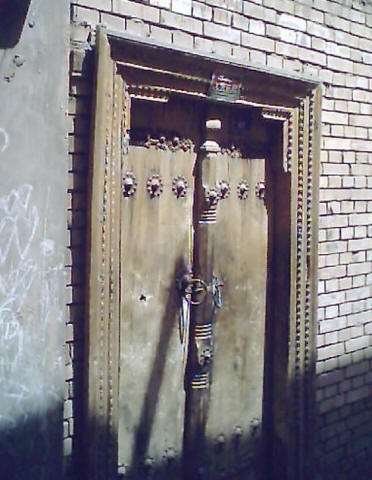
KASHGAR: Along the streets in the residential section of old Kashgar, homes
are safely tucked in courtyards behind heavy doors like these.
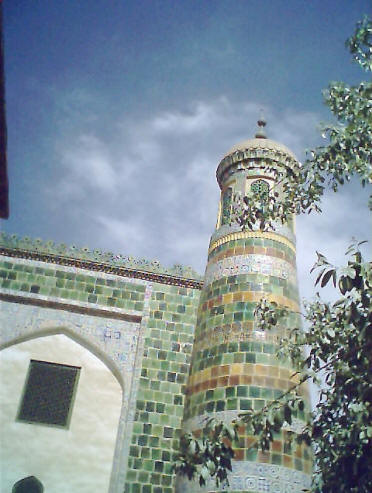
KASHGAR: One of the four towers at the Apak Hoja Tomb monument located in
the northeast suburbs.
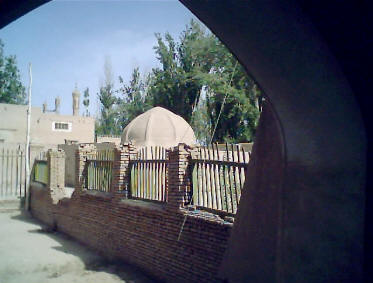
KASHGAR: Around the grounds at the Apak Hoja Tomb monument.
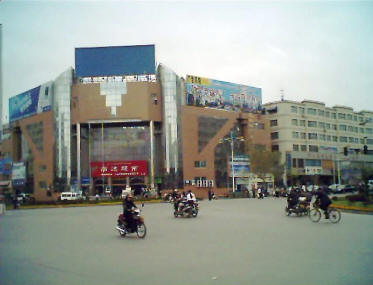
KASHGAR: NW corner of the main intersection at Renmin Road and Jiefang Road;
the center of town.
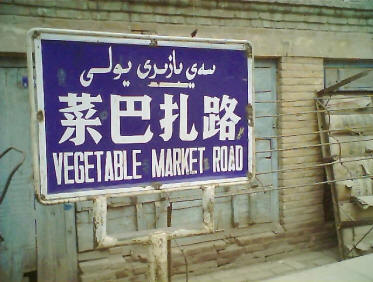
KASHGAR: On this road across the street from the main mosque crowds of
bearded Uyghur men congregate day and night to debate important issues.
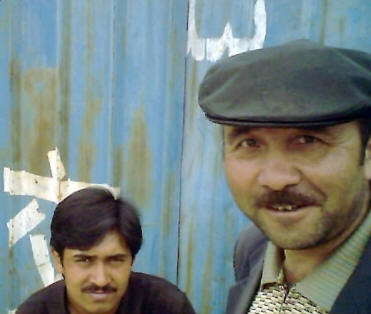
KASHGAR: A couple of the Uyghur men I met on the Vegetable Market Street
near the main mosque.
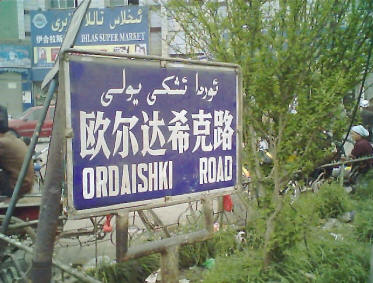
KASHGAR: A main cross street from Vegetable Market Street.

KASHGAR: this old guy never did smile to indicate he had friendly
intentions, though the younger guy behind him did.
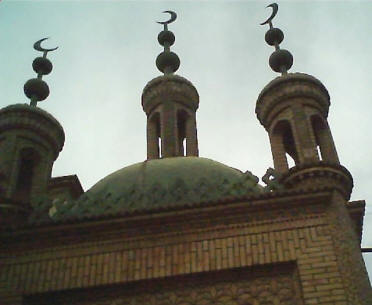
KASHGAR: One of the mosques in the old Uyghur section of town.
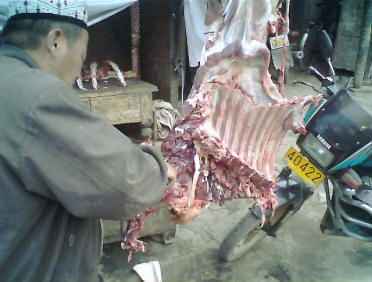
KASHGAR: Another butcher at work in the old Uyghur section.

KASHGAR: "Off with their heads!" Every part of the butchered goat is offered
for sale. I have no idea what delicacy is made from the heads. Head cheese?
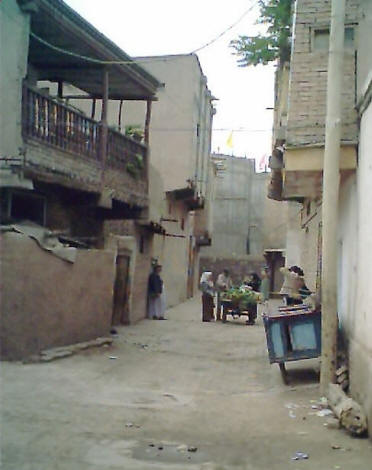
KASHGAR: Looking into a narrow residential ally.

KASHGAR: During a rare "rain storm" the light drizzle washed dust from the
air and deposited it on everything, including my shoes.
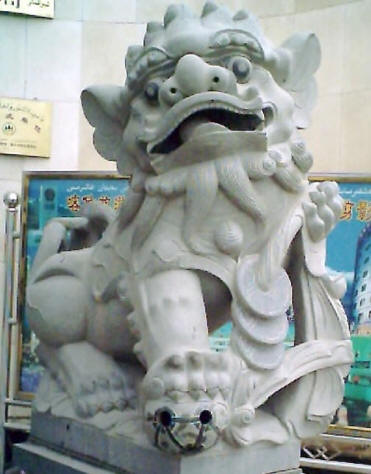
KASHGAR: One of the pair of lions guarding the entrance to the Qinibagh
Hotel where I stayed most of the time.
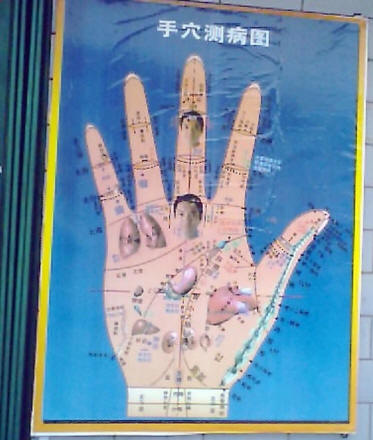
KASHGAR: Sign in front of a doctor's office.

KASHGAR: City Square next to People's Park.
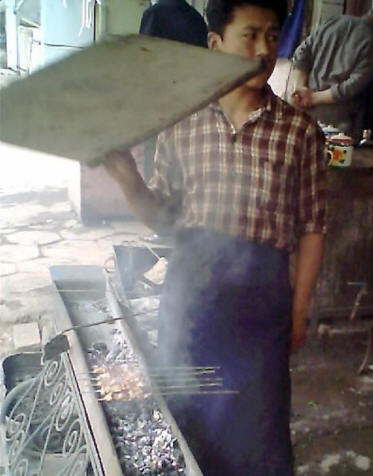
KASHGAR: Street vendor cooking kabobs.
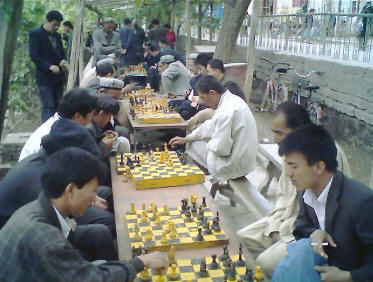
KASHGAR: Chess players. These guys are playing by the rules I know.
Obviously, rules vary from one place to another in China.
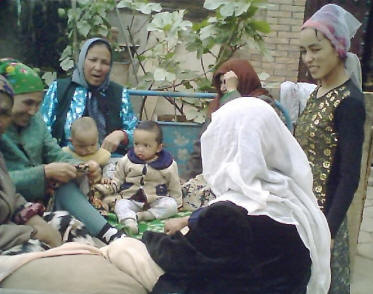
KASHGAR: Cute babies with a cluster of grandmothers. The young woman to the
right is the mother of kid nearest her.
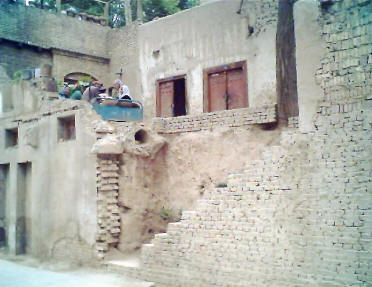
KASHGAR: Cute babies with a cluster of grandmothers are sitting near the old
city wall.
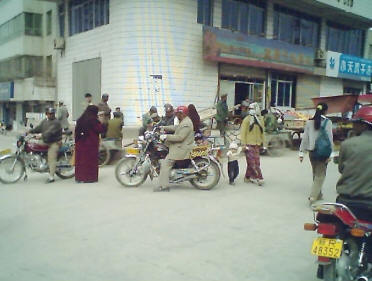
KASHGAR: Two wheel taxis waiting for fares. These guys operate all over
town, but especially in the old sections.
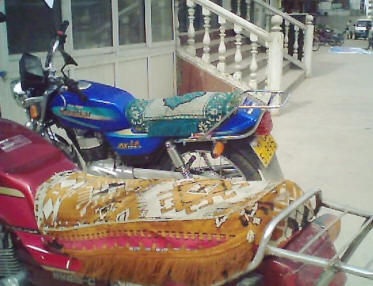
KASHGAR: All motorcycle seats are covered with saddle blankets like these.

KASHGAR: Another shot of People's Square looking toward statue of
Mao Zedong.
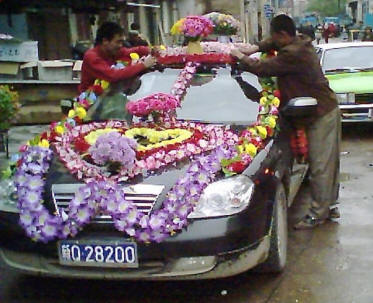
KASHGAR: Preparation of a car to be used in a wedding procession. The car
carrying the happy couple will drive around the center of town following a
pickup carrying a drum and trumpet band.
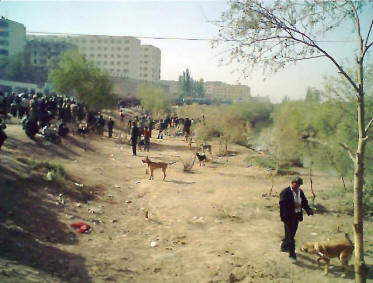
KASHGAR: Another view of the "dog market" where owners and buyers haggle
over price and qualities of their animals. Some of the animals seemed
agitated, possibly due to the fact a cat market is located not far away.
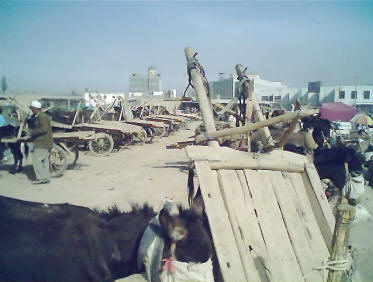
KASHGAR: Sunday Bazaar "parking lot" where donkeys and their carts wait for
the market to end many hours from now.
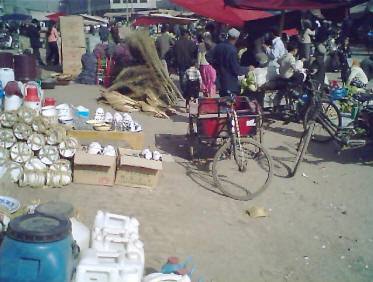
KASHGAR: Brooms, crockery, bicycles, oils all tempt buyers streaming by the
displays.
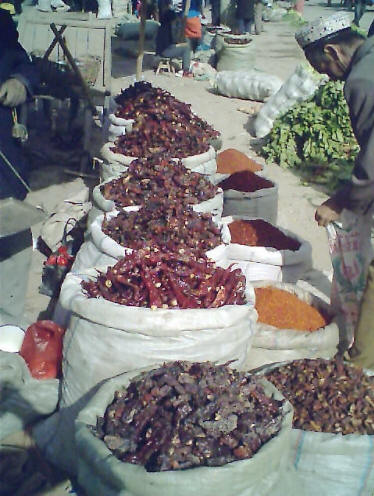
KASHGAR: Some like it hot and at the Sunday Bazaar peppers can be found in
abundance.
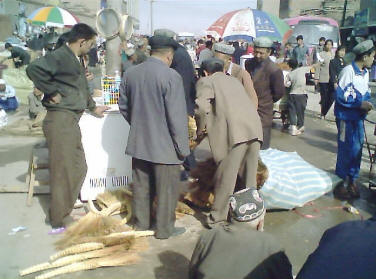
KASHGAR: Broom seller and several interested shoppers haggle over the merits
and price of a particular broom.
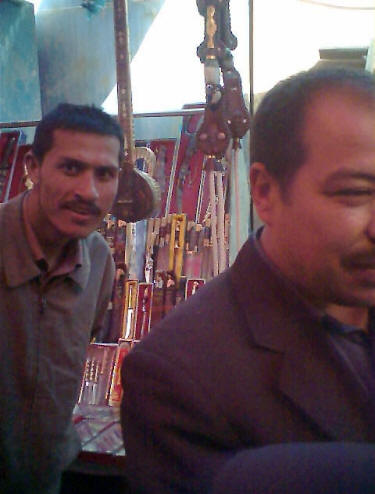
KASHGAR: While snapping pictures of knife displays, the guy in the
background took a special interest in my activities.
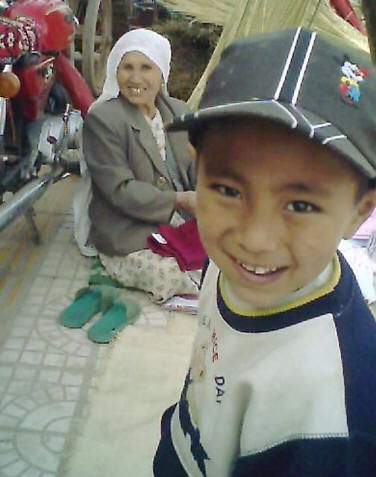
KASHGAR: Another proud grandmother in the background, delighted I might want
a picture of her pride and joy. The kid seemed to enjoy the attention, too.
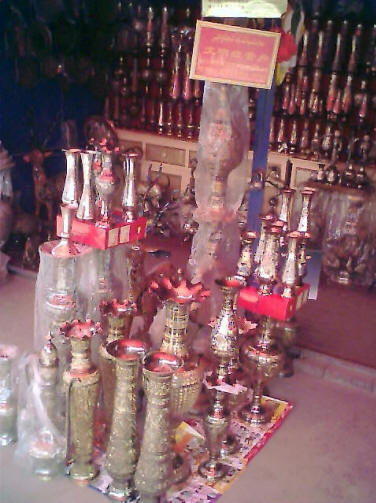
KASHGAR: A shop displaying brass crafts at the Sunday Bazaar.
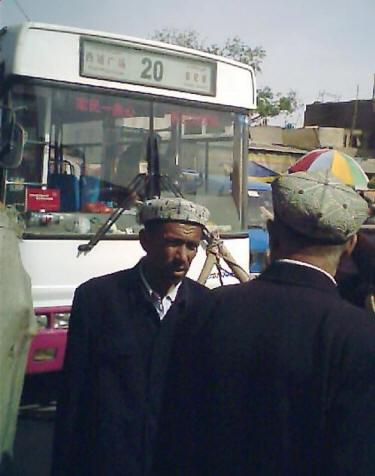
KASHGAR: The Number 20 bus pushes its way into the Sunday Bazaar. A new one
arrives every six minutes! To make any progress through the crowd, each is
equipped with an ear piercing shrill horn that blasts with the authority of
a cruise ship.
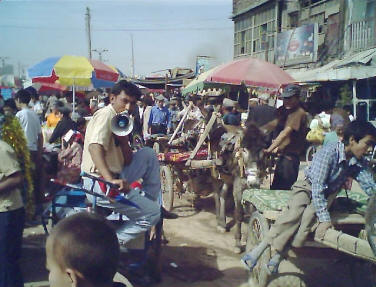
KASHGAR: Local shuttle service offers rides through the narrow, crowded
isles of the Sunday Bazaar.
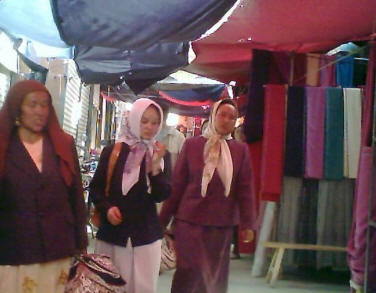
KASHGAR: Most of the narrow, crowded isles of the Sunday Bazaar are covered
by colorful "bed spreads" creating a welcome shade for shoppers.

KASHGAR: People dump their products on the ground for display anywhere they
can find some empty space at the Sunday Bazaar.

KASHGAR: Surrounded by a mob of shoppers this guy promotes the virtues of
his fabrics as ladies scramble to the choicest cloths.
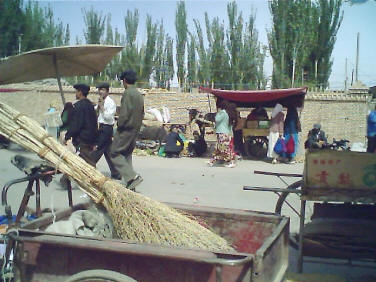
KASHGAR: As I rested in a shady nook out of the surging traffic, commercial
activity continued at the fringes of the market.
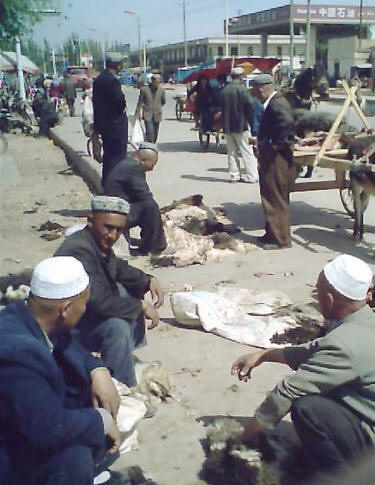
KASHGAR: Sheep skin traders at work near the north entrance to the Sunday
Bazaar. Many of the pelts, still wet were freshly removed from their
original owners.
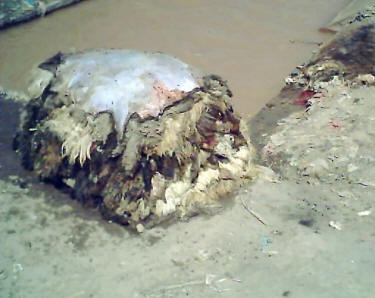
KASHGAR: Sheep skin traders near the north entrance to the Sunday Bazaar
have washed and stacked pelts that were freshly removed from their prior
owners.
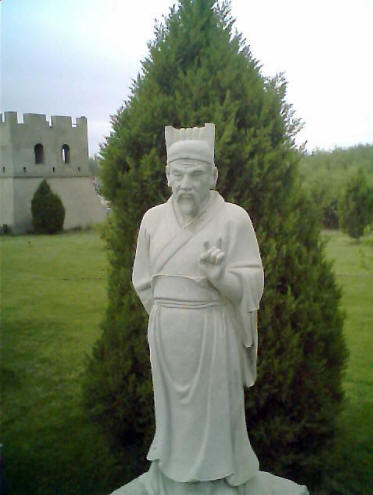
Pantuo City: The Banchao Memorial Park at Pantuo City outside of Kashgar.
One of Banchao's warriors. No one special. I just liked the sculpture.
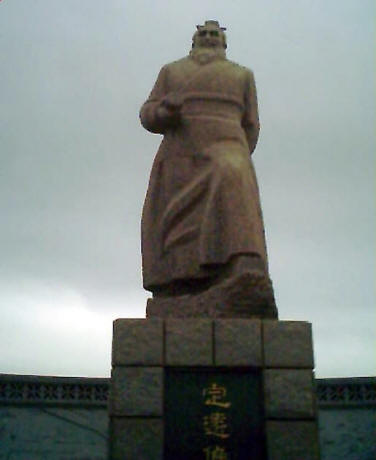
Pantuo City: The Banchao Memorial Park at Pantuo City outside of Kashgar.
That's Banchao.
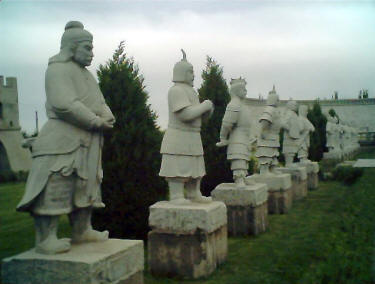
Pantuo City: The Banchao Memorial Park at Pantuo City outside of Kashgar.
Honor guards with the statue of the clever Han warrior Ban Chao who
maintained order in the Western regions during the first century.
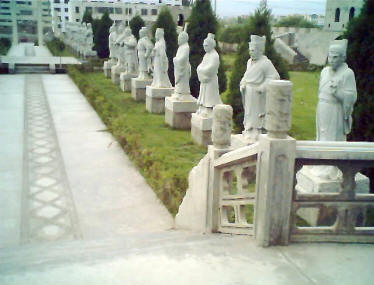
Pantuo City: The Banchao Memorial Park at Pantuo City outside of Kashgar.
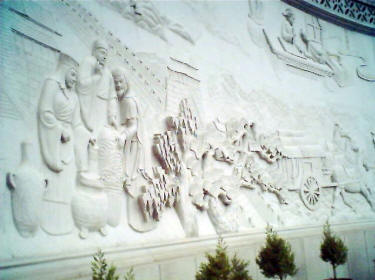
Pantuo City: The Banchao Memorial Park at Pantuo City outside of Kashgar.
Bas-relief mural around the statue of Banchao. 2

Pantuo City: The Banchao Memorial Park at Pantuo City outside of Kashgar.
Bas-relief mural around the statue of Banchao. 4
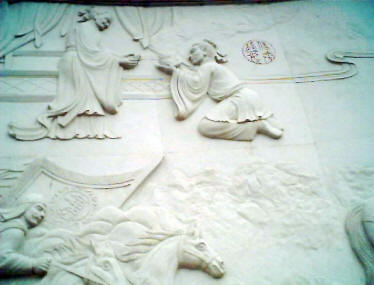
Pantuo City: The Banchao Memorial Park at Pantuo City outside of Kashgar.
Bas-relief mural around the statue of Banchao. 6

Pantuo City: The Banchao Memorial Park at Pantuo City outside of Kashgar.
Bas-relief mural around the statue of Banchao. 8
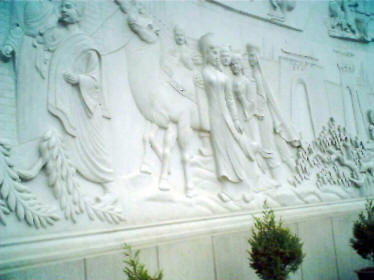
Pantuo City: The Banchao Memorial Park at Pantuo City outside of Kashgar.
Bas-relief mural around the statue of Banchao. 10

Pantuo City: The Banchao Memorial Park at Pantuo City outside of Kashgar.
Bas-relief mural around the statue of Banchao. 12 |
  22 April 2004 22 April 2004
Hello from Kashgar
China,
I finally made it all the way down the
railroad line to the farthest southwest corner of the Xinjiang Autonomous Region
of China. Leaving Aksu city by train I arrived early afternoon in
Kashgar. Leaving Urumqi on 14 April I made
short stops in Turpan, Korla, Kuqa, and
Aksuma before arriving in Kashgar on 22 April. I'd say I have finally reached
the "real China," but there are hardly any Chinese here! Everywhere I look I see
Uyghur in their characteristic caps called Dopas. A friend pointed out it would be helpful to include an on-line map
for some of the obscure places I'm exploring. So, I found this
map of the area around Kashgar. It is particularly good for examining the
western borders of China and the rest of Central Asia.
On the train I
met Xie Ting Yu, a 24-year-old student in her fourth year of medical school in
Urumqi studying Ophthalmology. The eldest of three sisters, she is fulfilling her
father's thwarted ambitions. His hope to become a doctor was interrupted by the
Cultural Revolution. She will delay marriage until she is thirty and finishes
school. She got off the train in a tiny desert community about two hours before
the train arrived in Kashgar. She noted water is more precious there than
electricity.
Several #28 city
buses sat waiting at the station for passengers, whisking us into the center of
the city in a half hour. I started my usual hotel-shopping hike immediately.
Initial impressions suggested there were few hotels anywhere in the city.
Eventually, I settled on the 198-Yuan ($24) Wen Zhou Mansion a half block from
the city center. Later I discovered the area is crowded with good hotels tucked
into alleyways and in the upper stories of tall buildings.
I'd say I have finally reached the
"real China," but there are hardly any Chinese here! However, despite the heavy
concentration of
minority people, this is still China and has been for thousands of
years! Now that I have learned a little spoken Han Chinese and can recognize a
few important Chinese characters, everyone is speaking Uyghur and writing things
with an Arabic script! Everywhere I look I see Uyghur men in their
characteristic caps called Dopas and women with their heads completely covered
by heavy brown knitted "baby blankets" called Yarlucks. Some of the uncovered
women wear surgical masks, more a defense against the pervasive dust than a
religious observance I suspect.
In the old Uyghur
sections of the city traditional customs continue to dominate the lives of the
people. Tourists are tolerated for the most part. Some of the stores cater to
the interests of tourists. However, I see very few Westerners anywhere other
than in the vicinity of the banks and upscale hotels, especially the Seman Hotel
area favored by the backpacking crowd.
The ancient
1600-year-old wall is still standing in an area near the Qinibagh Hotel, the
former British Consulate where I spent most of my stay. Preserved by the dry
desert air, some sections are in amazingly good condition. However, wherever
recent development has encroached on the wall, the wall has given way. Parts of
it have been removed to allow roads to pass through. In other sections buildings
incorporate the wall as part of the new structure. Teeth marks from earth moving
equipment can be seen on the wall at several places.
At one point I
started to snap another picture of the wall through the bars of a gate. Off to
the side a gentle voice and movement attracted my attention to a sign on an
adjacent building: "Military Administration Zone." The soldier gestured "no
photography allowed." I doubt the ancient defense barrier has any military
significance these days and found the possibility humorous.
Food is proving
to be a problem. Finding something I recognize as edible often has been limited
to ice cream bars, rice, noodles, kabobs (though the lamb usually ends up as
tough ram) and beer. The Muslims don't drink, so I know there are infidel
Chinese in these parts; the few western tourists can't be responsible for all
the beer being consumed here.
The Internet
cafes here all are well lighted and offer modern equipment and recent versions
of Windows. All I have checked out have kept the lights on and smoking is less
frequent than in other cities. All charge a minuscule two RMB per hour, about
twenty-five cents. The best one is off the lobby of the Seman Hotel, formerly
the Russian Consulate.
Sidewalks are
designed for both pedestrians and two wheeled vehicles. Wheelchairs rarely use
the ramps at corners; mostly they help motorcycles speed along. The central
government has obviously created incentives for cities to all use the same red,
yellow and white sidewalk tiles all over China. Everyplace I've stopped has had
the same colors and tile designs.
There are many
beggars on the streets, some in tatters. None are obnoxious and receive with
sincere gratitude the small donations (one or two cents) passersby give them.
The giving and the receiving remind me of the ritual practiced by the monks in
some Buddhist countries. The monks stand passively, receiving the gifts of food
as a means of allowing the devoted to experience charity.
There are no CNN
or BBC channels here. CCTV does have a couple English language channels. The
news is kept uncontroversial. For example, a report of the explosion in the DPRK
a few days ago with a hundred and thirty dead focused on China's humanitarian
relief efforts. Cause of the explosion finally got mentioned in passing today
with little detail: strange for a disaster of such magnitude. On the other hand,
cultural and historical programs have been wonderful. The Chinese equivalents of
our old Westerns are educational and usually entertaining, though exclusively in
Chinese. Many deal with epic historical events.
I met an
unregistered Christian evangelist who told me the government requires religious
teachers to undergo a period of indoctrination before allowing them to become
registered religious leaders. Registration gives groups certain benefits, but
requires limitations on the teaching of rigid dogmas... like claims of
scriptural infallibility, etc. The owner of the Seman Hotel cyber cafe,
Abdulwahab is a Uyghur Muslim. In several conversations with him I learned the
Islam practiced here in this part of China is rather moderate. Violent jihad is
not advocated. Indeed the government prohibits it. His brother, Abdulrekib is an
Imam working days in my hotel and finds no conflict between the Qur’an, as he
understands it and the significant limits imposed by the government.
A few of the
Uyghur men appear to be zealots, extreme fundamentalist Muslims, but the
majority is quite moderate in my observations. I hear no call to prayers by
muezzins. In fact, only during the Friday noon activities did I see anything
that looked like organized religious observance in this predominantly Muslim
city.
My first Sunday I took a #20 bus into
the midst of the extraordinary Sunday Grand International Bazaar.
I spent the morning pushing my way through endless crowded isles of exotic
products and even more exotic shoppers, snapping pictures as I went. The noise,
the music, the smells, the donkey carts all managed to create a totally foreign
experience. I loved it. Women in their finest metallic embroidered or sequin
covered dresses and scarves dashed around shopping like women everywhere. Donkey
cart taxis worked their way through crowded isles, the often young boy drivers
shouting "Bosht, bosht" at shoppers to get out of the way. Every imaginable
product graced the display tables and ground covers. Things I saw being offered
for sale included fabrics, elaborately crafted knives, farm produce, meats, dogs
and cats (for pets!), goats, cattle and sheep (for food), tea cooled over large
chunks of ice, meat kabobs, fresh peeled fruit and more. One liter bottles of
beer cost the same as liter bottles of mineral water which costs the same as a
can of Coke: three Yuan or thirty-seven cents. Actually, the beer has a
surprisingly good fruit-like flavor. It reminds me of the fragrance of flowers.
A half block east
of city center is a large statue of Mao Zedong standing across the street from
People's Square. Everything seems to be in easy reach of walking or the
excellent city bus system. Bus rides are one Yuan (twelve cents). Taxi rides to
anywhere in the city are a flat five-Yuan. There are "super" markets, but they
give new meaning to the word "super!" Almost no western goods are on display.
There are no McDonald restaurants, no KFC's. One Chinese franchise, Best Food
Burgers tries to mimic the McDonald's operations, but fails in quality and
efficiency.
People scream
into their cell phones. Sometimes I wonder if they are not trying to attract
attention to the fact they can afford one of these status symbols. Peasants in
their old style clothes on the street carry expressions of bewilderment, wonder.
It is striking what an education and exposure to modern influences can do for
people. I have seen many preschool kids crying on the street in response to
parent's refusal to meet their demands.
The very helpful
government travel agent in the China International Travel Service, CITS called
the Urumqi Kyrgyzstan Airline office and confirmed Americans can get a
Kyrgyzstan visa in Bishkek, if they fly into the country on Kyrgyzstan Airline;
no advance planning required. There is only one flight weekly out of Urumqi on
Tuesday. That sounds perfect to me as all the other nearby countries require
visa applications to be processed in Beijing. While this can be handled by mail,
there are extra costs and the process takes at least ten days.
With four daily
flights back to Urumqi I learned of the big difference in fares for tickets
bought today (1230 Yuan or $154) and those bought five days in advance (490 Yuan
or $61). Naturally I bought the cheap ticket, which can be changed, if
necessary by paying an $18 penalty... still half price. Today I made a trial run
to the airport and discovered the 10:50 flight I've booked for Sunday has been
delayed 12 hours for today's flight... something everyone says is common.
My last day
before flying back up to Urumqi I switched hotels to be closer to airport
transportation. The day I checked into the 150 Yuan per night Heng Yuan
Hotel all power had been cut to permit workmen to complete construction of the
new building. I assumed the power outage and unavailability of an elevator would
be for a short time only and obligingly climbed the five flights of stairs to my
room. By the time it had turned dark the power still had not been restored.
Undaunted, I descended the darkened stairs to the candle lit restaurant on the
second floor for dinner and discovered no one spoke much English. I pointed to
the Chinese character for "chicken" in the description of an item on the
menu, flapped my elbows and clucked. Soon, the entire kitchen staff, waiters and
waitresses, hotel management, and reception desk staff had congregated to
discuss my dining needs. As I could not answer any of their questions about what
I might like with my chicken or how I might like it cooked, an animated debate
ensued. Everyone clearly concerned I should have a memorable dining experience
in their recently opened hotel dining room.
Eventually, a
dish of garlic mushroom chicken appeared, along with rice, carrots, a dish of
fresh fruit and a glass of hot tea... plus a knife and fork. Aside from the fact
the chicken had been chopped into bite size pieces by a sadistic chief who
managed to embed bone splinters in every bite, I found it a gourmet delight. A
half dozen staff hovered over and around my table watching my every move with
anticipation. When the bill came I thought someone had made a mistake:
twenty-one Yuan or about $2.60 including candles, tax and tip! (Taxes are never
added and tipping is not expected... indeed, on one occasion I had a waiter rush
after me with the few Yuan I had "forgotten.")
I'll remain in China a while longer and
then head into one or more of the central Asian countries. It now looks like my
best option will be to fly back through Urumqi and then on into Bishkek where I
can get a
Kyrgyzstan visa at the airport on arrival. Other options are much more
complicated. Yesterday the U.S. State Department issued a travel
warning for Kyrgyzstan, so I move into high alert.
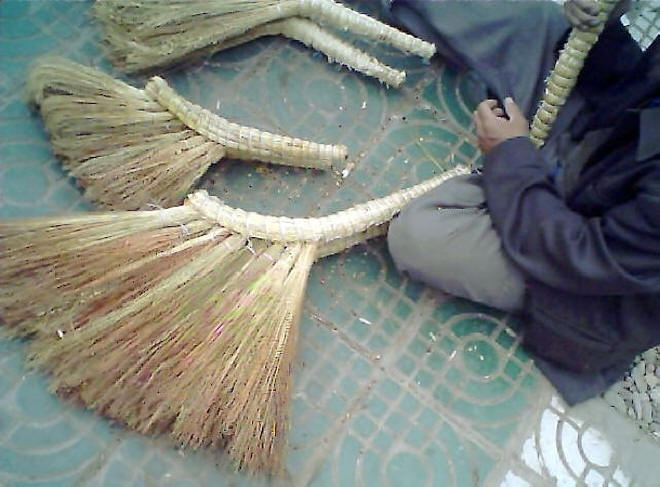
KASHGAR: Close-up of the
whisk brooms handmade by the sellers.
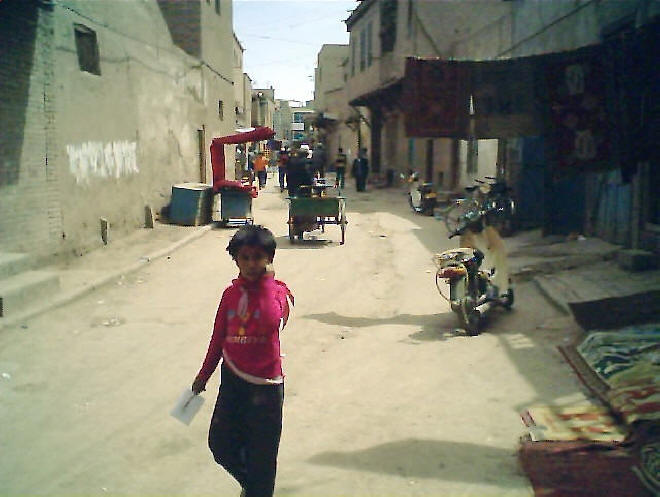
KASHGAR: Notice the packed dirt on this main street through one of
the old Uyghur areas.
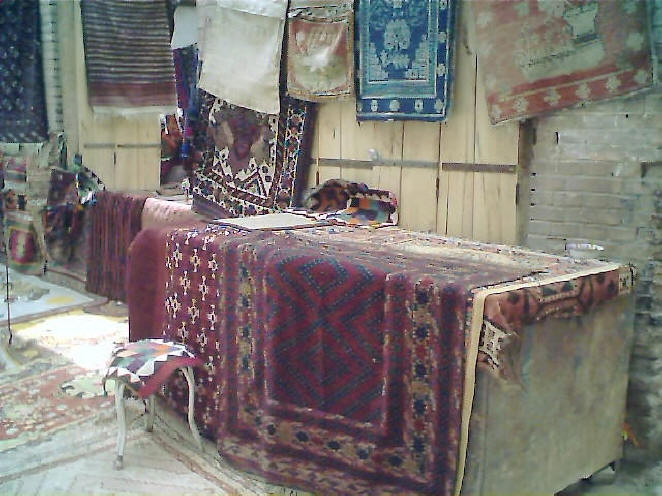
KASHGAR: A carpet merchant displays some of his wares along a main
shopping street in the old section.
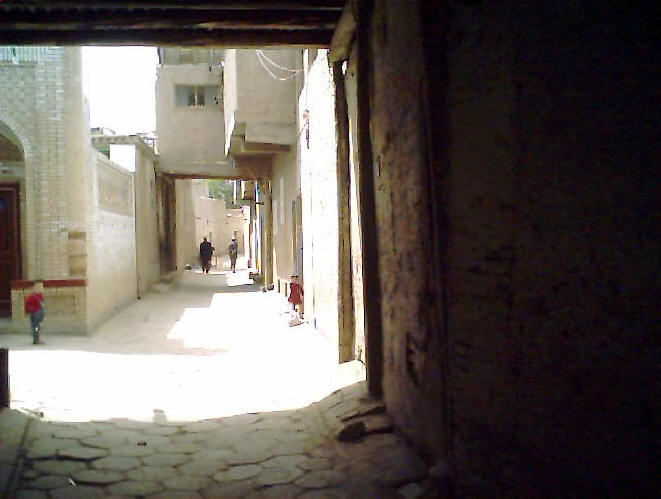
KASHGAR: Looking down one of the residential streets in the old
Uyghur section.
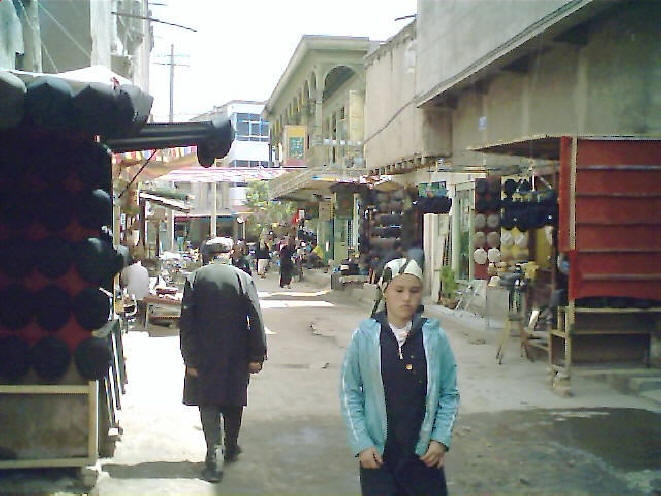
KASHGAR: Along one of the main shopping streets in the old Uyghur
section. Note the packed dirt street which are constantly sprinkled
with water and swept clean.
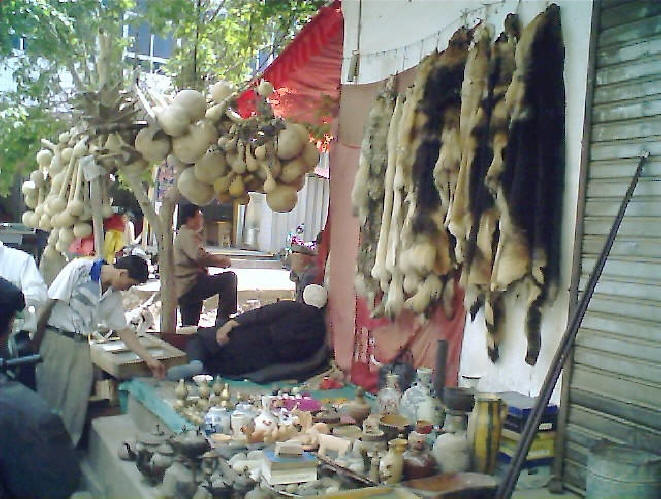
KASHGAR: One of the shops in the old Uyghur area offering goods of
interest to tourists.
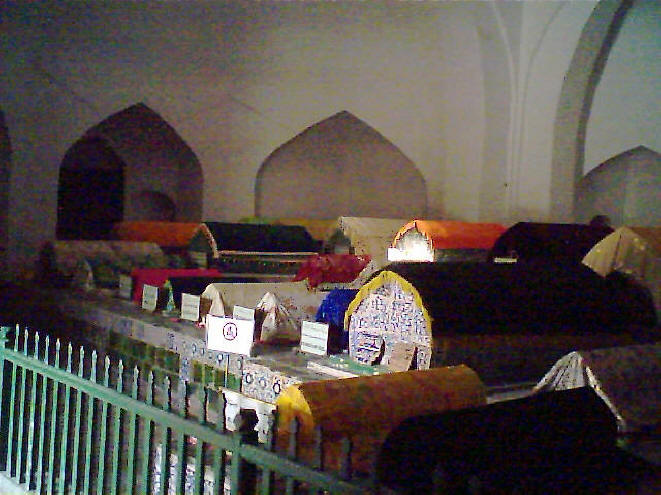
KASHGAR: Inside the mausoleum at the Apak Hoja Tomb monument.
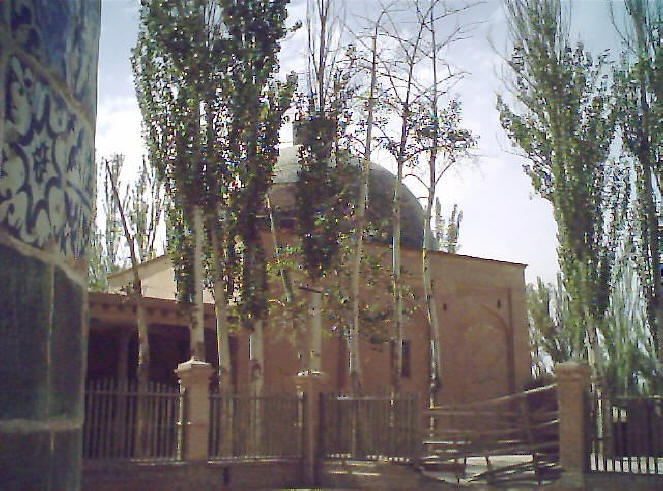
KASHGAR: Around the grounds at the Apak Hoja Tomb monument.
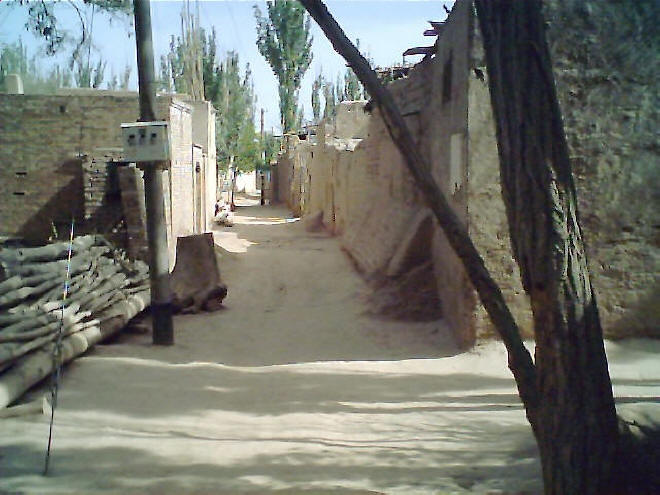
KASHGAR: Looking down one of the residential streets near the Apak Hoja Tomb
monument.
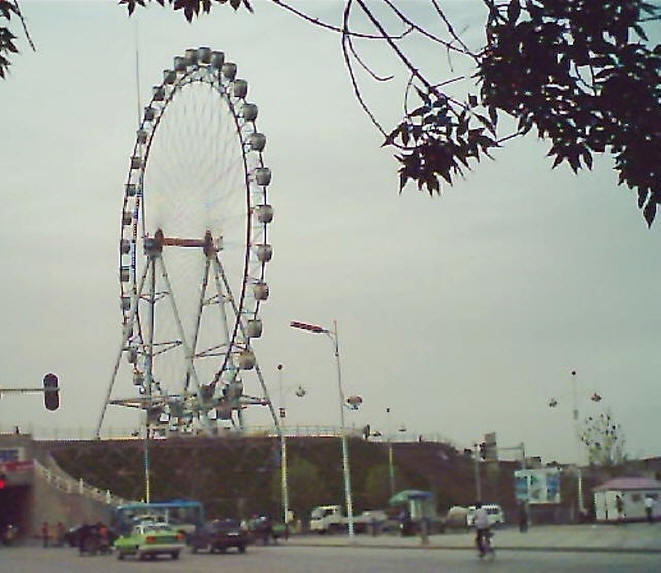
KASHGAR: The Giant Ferris Wheel is a landmark near the lake to the east of city
center.
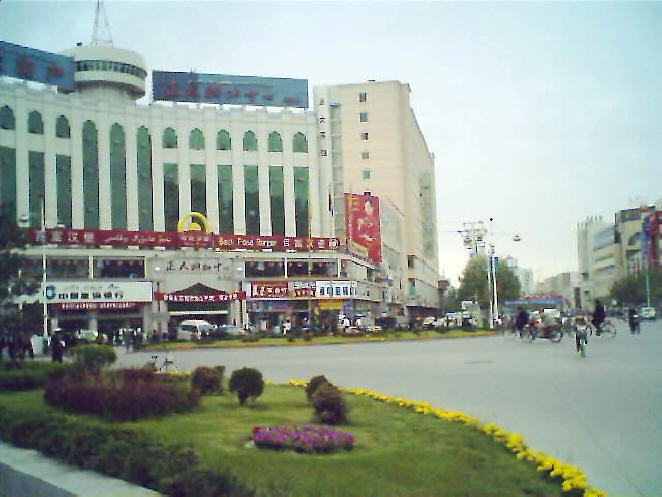
KASHGAR: SW corner of the main intersection at Renmin Road and Jiefang Road; the
center of town.
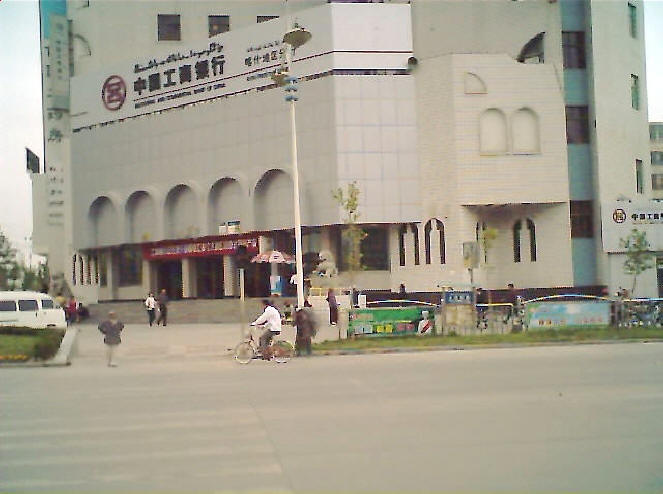
KASHGAR: SE corner of the main intersection at Renmin Road and Jiefang Road; the
center of town.
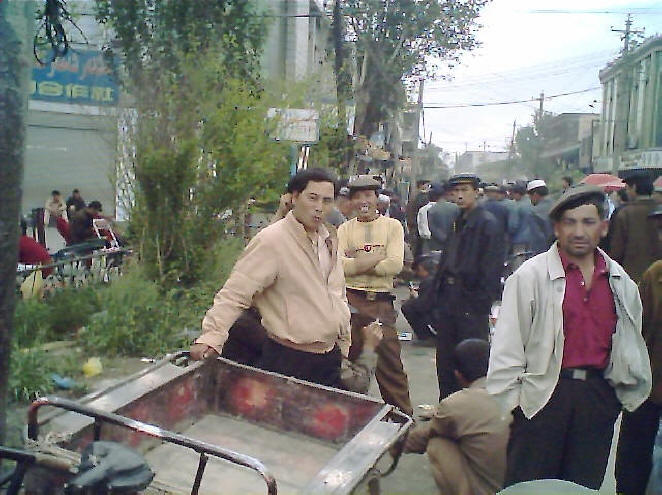
KASHGAR: Uyghur men take notice of my photographic activities on the market
street near the main mosque.
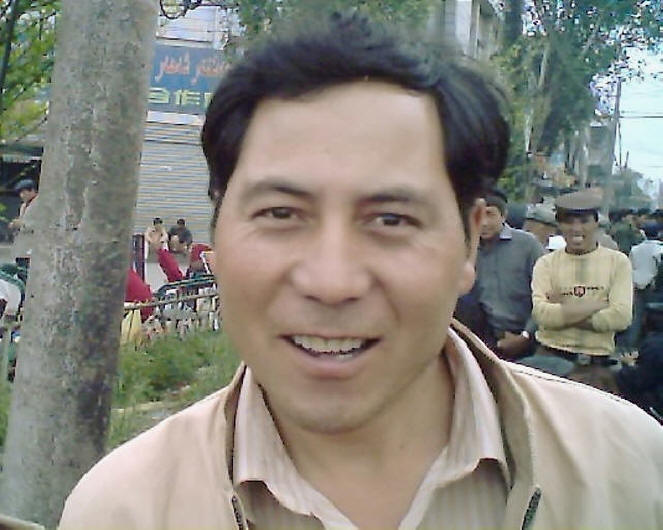
KASHGAR: This fellow insisted on a closer look at my strange gadget. Of course,
with all the foreign tourists they have seen many cameras, but this little thing
is a marvel.
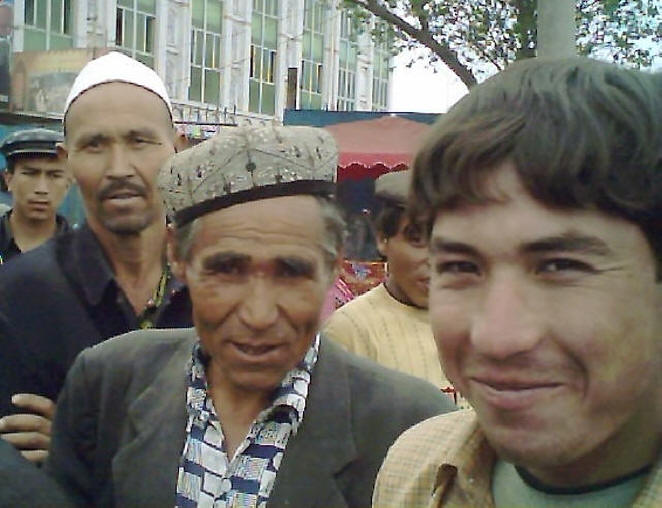
KASHGAR: Soon, a crowd gathered and continued to grow as I "explained" the
operation of a digital camera and the Internet... all with only a few words of
Chinese and no Uyghur! ... but lots of gestures!
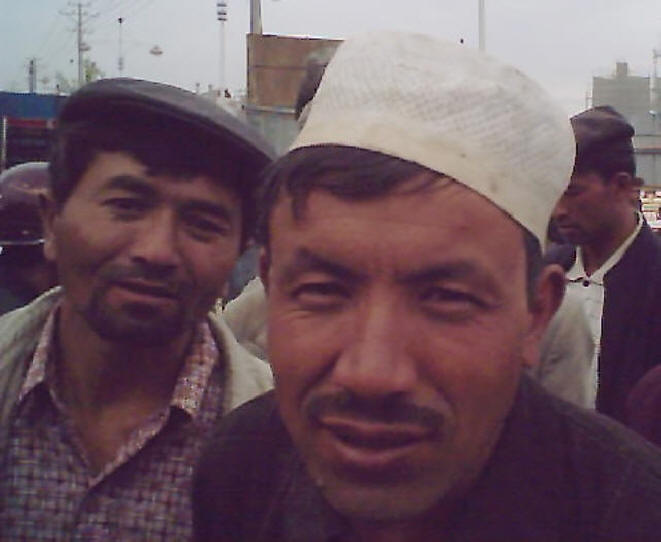
KASHGAR: Several guys got overly interested in my activities.
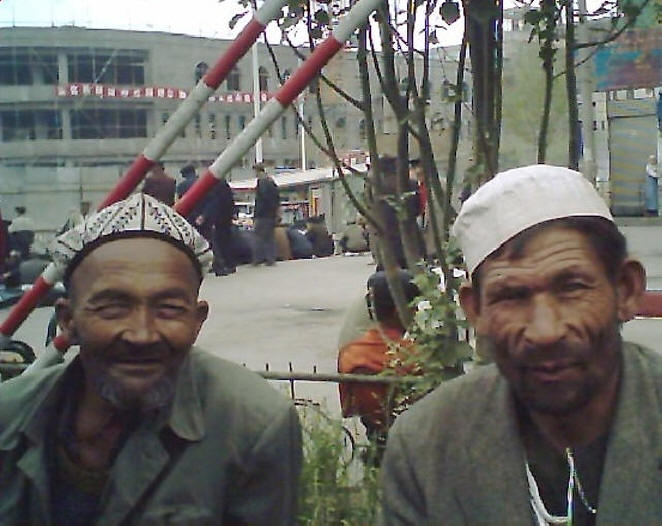
KASHGAR: People kept crowding in for a closer look and I kept snapping pictures.
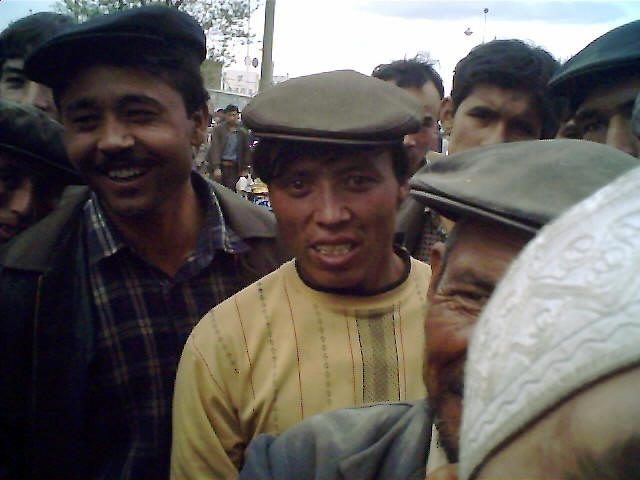
KASHGAR: The guy in the yellow shirt followed me around as I snapped pictures of
people on the market street near the main mosque.
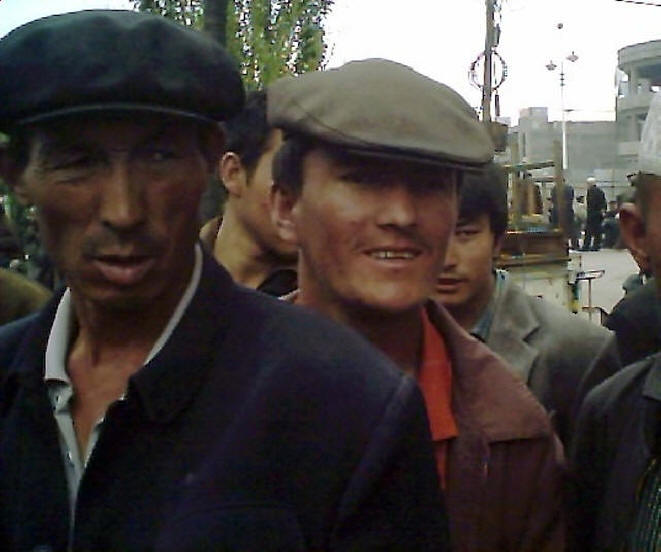
KASHGAR: Another group of the people who crowded around me on the market street
near the main mosque: here three deep.
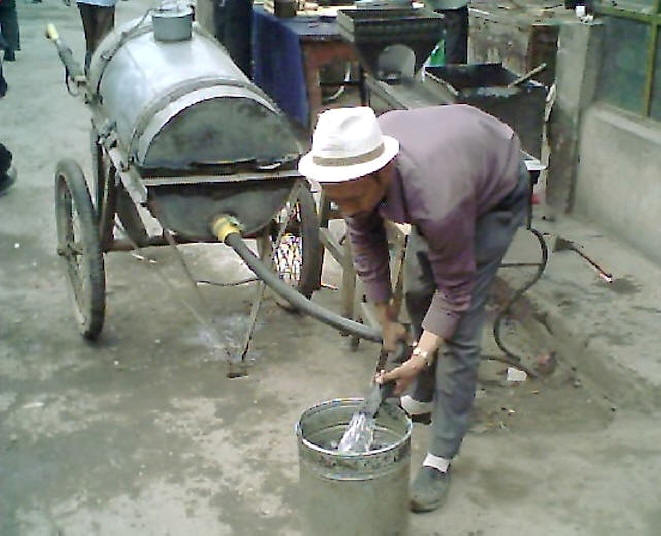
KASHGAR: The water seller.
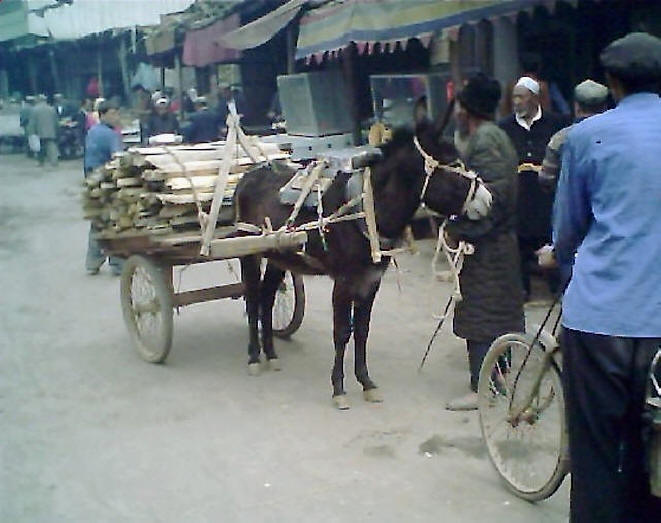
KASHGAR: I see as many donkey powered delivery carts as motorized versions.

KASHGAR: Butcher at work in the old Uyghur section.
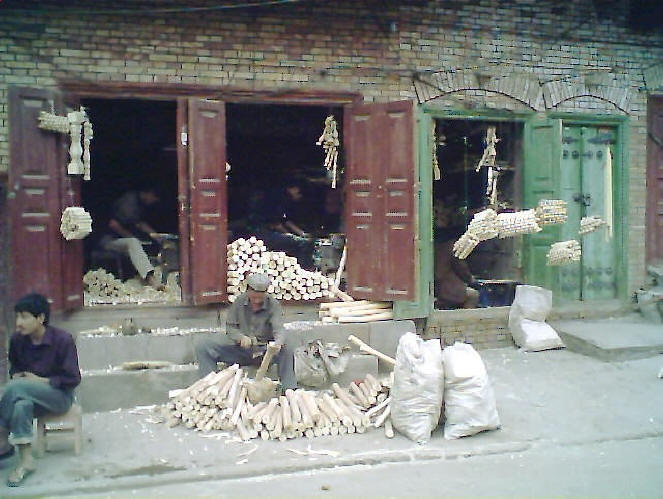
KASHGAR: Most of the shops along this street in the old Uyghur section are
making "table legs" on small lathes.
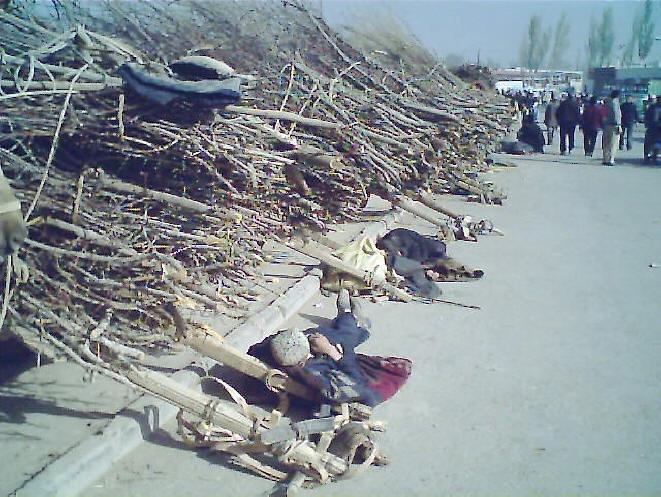
KASHGAR: Along the entry road to the Kashgar Sunday Bazaar I came upon a row of
carts full of tree cuttings. Here the resting drivers are seen by their carts
waiting to deliver the load to a buyer.
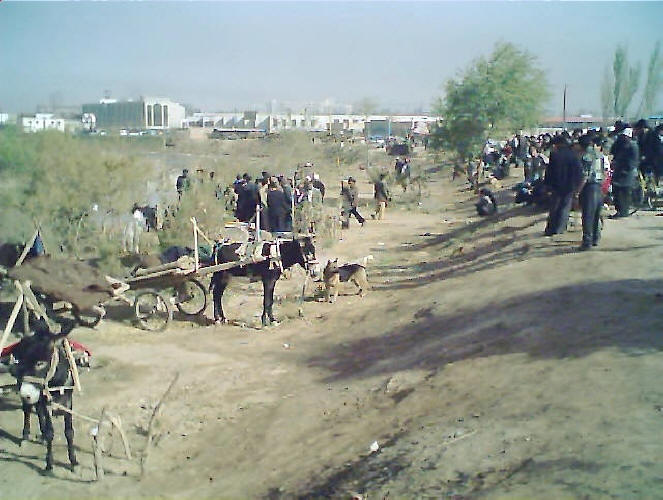
KASHGAR: A view of the "dog market" where owners and buyers haggle over price
and qualities of their animals.

KASHGAR: One entire section of the Sunday Bazaar is devoted to hardware.
Individual craftsmen spread their wares in the area of established stores for
easy shopper comparison.
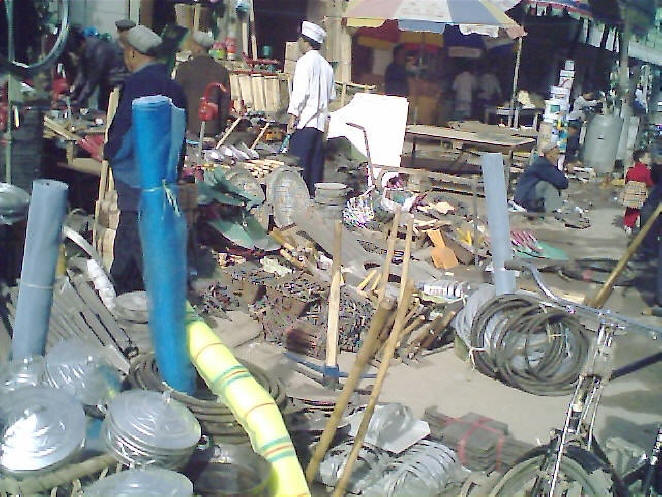
KASHGAR: One entire section of the Sunday Bazaar is devoted to hardware. This
large display includes a wide range of products.
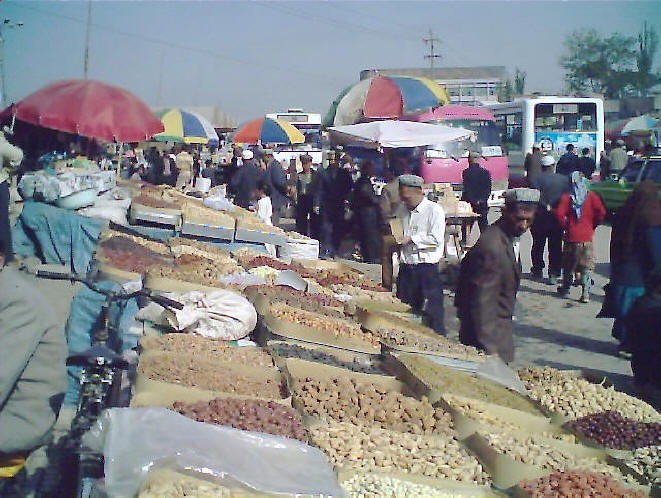
KASHGAR: Nuts of all kinds displayed side by side at the Kashgar Sunday Bazaar,
a scene which has not changed for centuries.
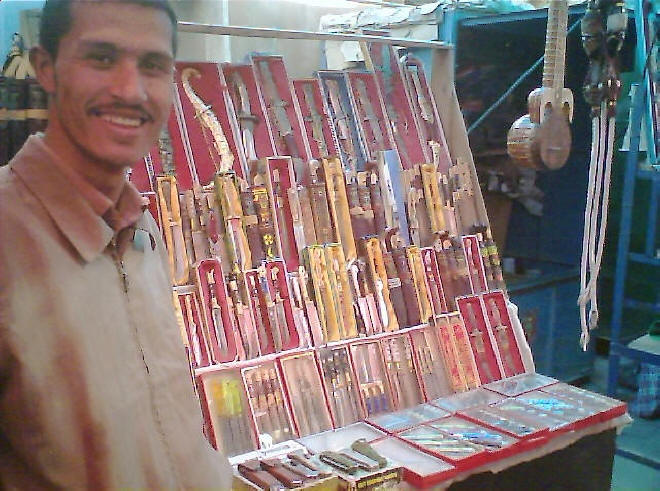
KASHGAR: While snapping pictures of knife displays, this guy took a special
interest in my activities and insisted I shoot his display as well. I motioned
him to move into the picture which he did reluctantly.

KASHGAR: Nuts, nuts, nuts at the Sunday Bazaar.
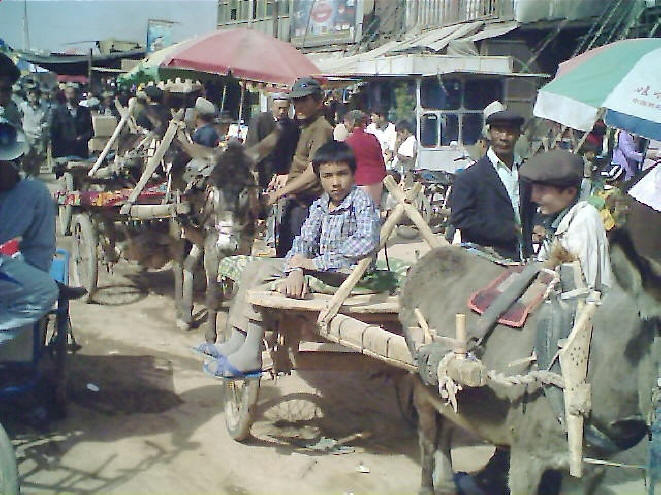
KASHGAR: Local taxi service offers rides through the narrow, crowded isles of
the Sunday Bazaar. Many of the drivers are not more than twelve years old.
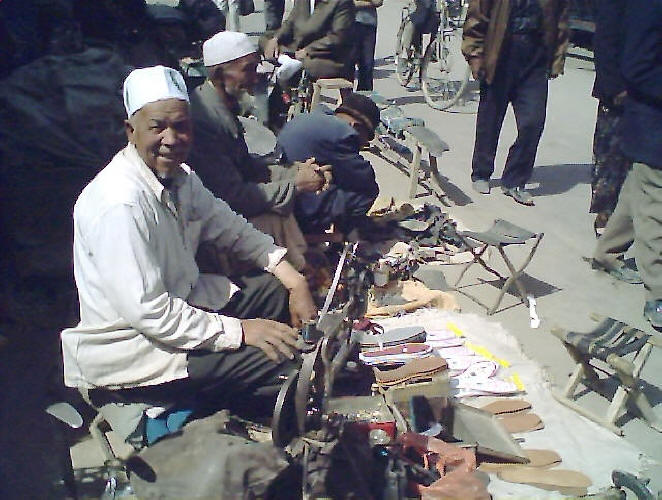
KASHGAR: Cobbler ready for work and awaiting a customer. He seemed amused by my
interest in the hand powered leather sewing machines and motioned for me to take
his picture with his machine.
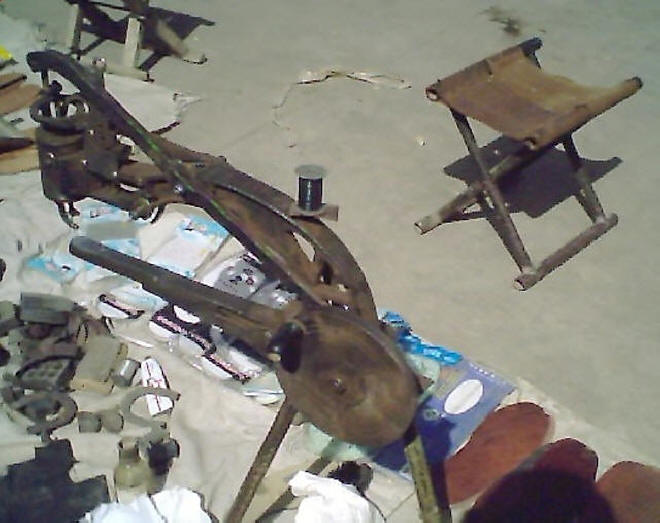
KASHGAR: Close up of the hand powered leather sewing machines used by the street
cobblers at the Sunday Bazaar.
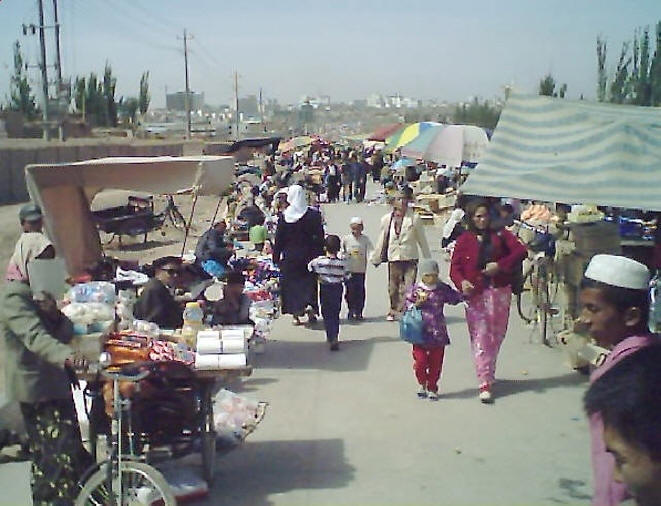
KASHGAR:
Who is that masked woman to the left selling toilet paper? Whatever you want you
will find it at the Sunday Bazaar.
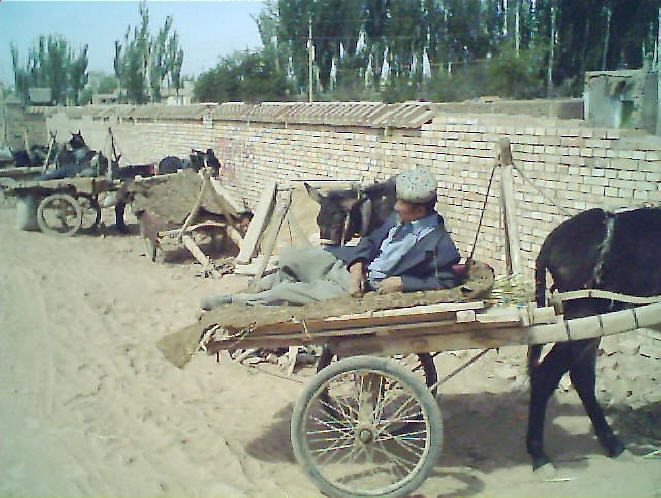
KASHGAR:
Donkey cart driver rests through the hottest part of the day waiting for the
market to end.
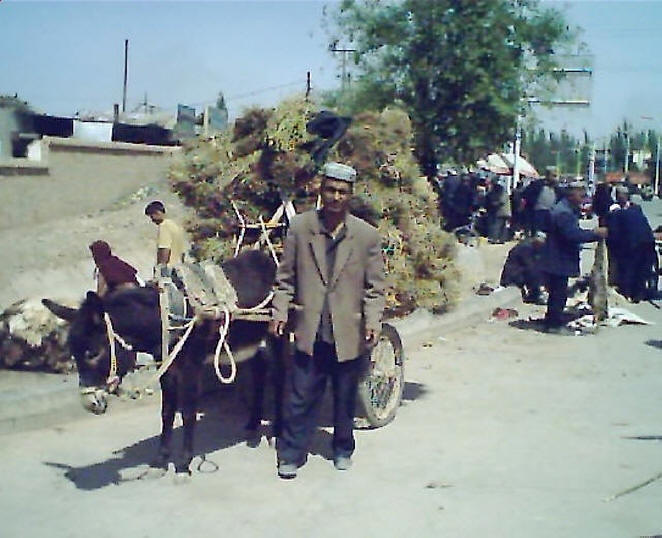
KASHGAR:
Raw materials for brooms being delivered by donkey cart at the Sunday Bazaar.

KASHGAR: Most of the narrow, crowded isles of the Sunday Bazaar are covered by
colorful "bed spreads" to shield people from the hot blazing sun.
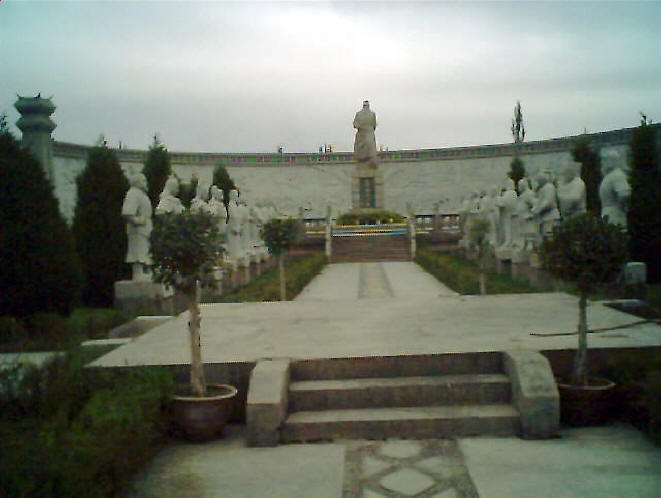
Pantuo City: The Banchao Memorial Park at Pantuo City outside of Kashgar.
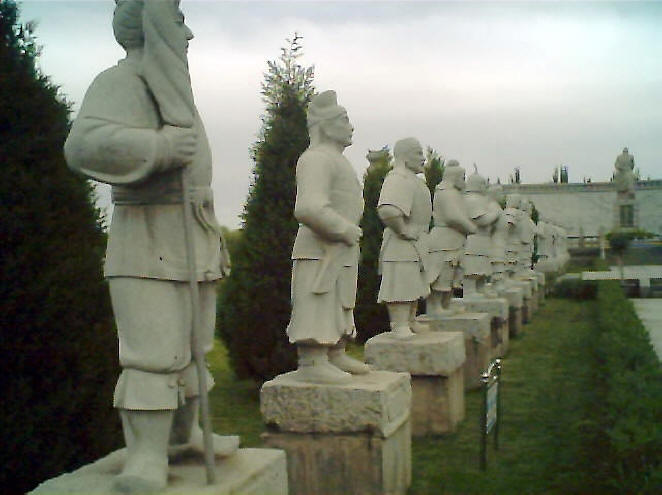
Pantuo City: Left row of warriors standing to honor the ancient hero, Banchao at
the far end.
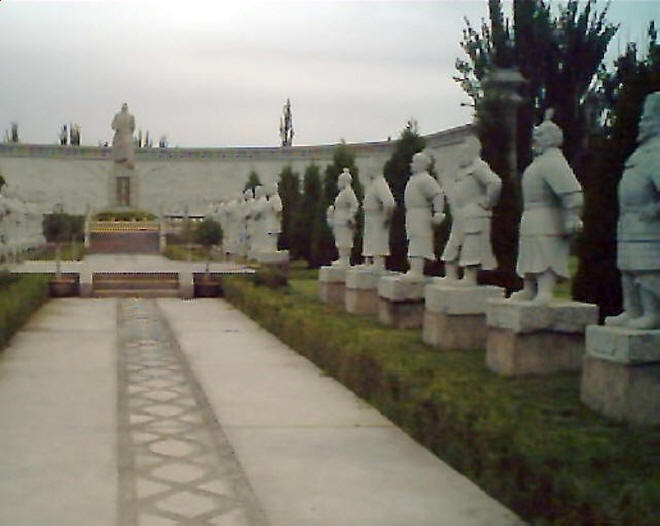
Pantuo City: The Banchao Memorial Park at Pantuo City outside of Kashgar. Right
row of warriors standing to honor the ancient hero, Banchao at the far end.

Pantuo City:
The Banchao Memorial Park at Pantuo City outside of Kashgar. Note that each
warrior wears unique head gear.
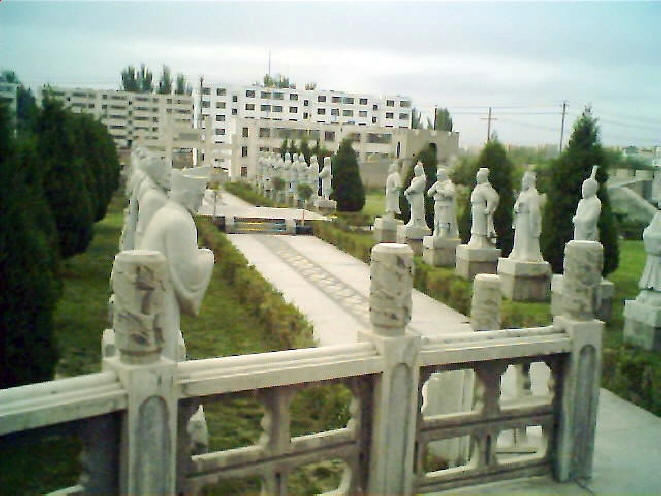
Pantuo City:
The Banchao Memorial Park at Pantuo City outside of Kashgar. Looking out toward
the entrance.
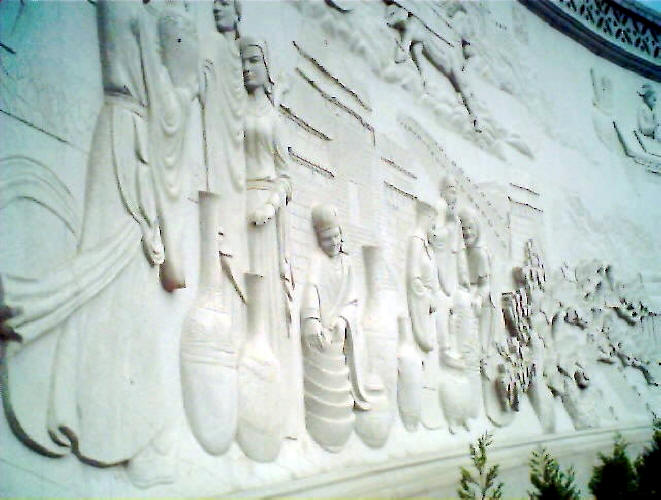
Pantuo City:
The Banchao Memorial Park at Pantuo City outside of Kashgar. Bas-relief mural
around the statue of Banchao. 1
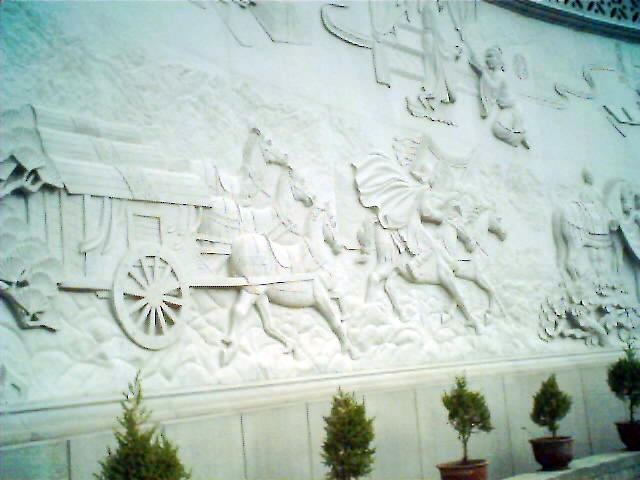
Pantuo City: The Banchao Memorial Park at Pantuo City outside of Kashgar.
Bas-relief mural around the statue of Banchao. 3

Pantuo City: The Banchao Memorial Park at Pantuo City outside of Kashgar.
Bas-reliefs mural around the statue of Banchao. 5
|
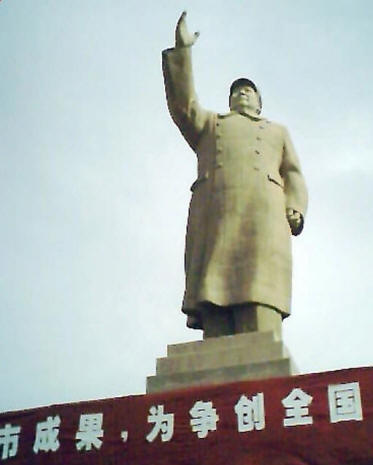
KASHGAR: Large statue of
Mao Zedong near the People's Square.
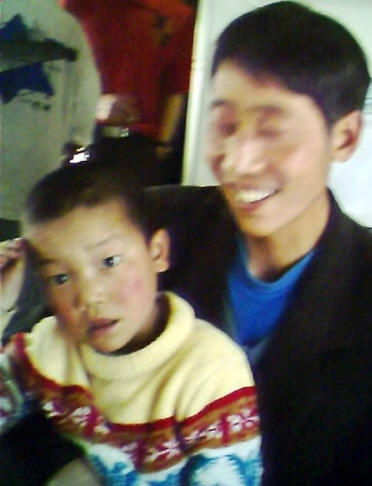
KASHGAR: This little kid couldn't keep his eyes off me on the train from
Aksu to Kashgar. His father seemed to want him to get a full dose of
foreigner exposure.

KASHGAR: Meet Xie Ting Yu, a fourth year medical student in Urumqi on her
way home to a small desert community several hundred kilometers from
Kashgar. The eldest of three sisters, her father wants her to fulfill his
childhood dreams of becoming a doctor... thwarted by the Cultural
Revolution. She is planning to specialize in Ophthalmology. In her small
village water is more precious than electricity. We talked for a couple
hours as she practiced her already good English.

KASHGAR: I watched a large evening gathering of men as they discussed
weighty world matters in animated groups near the main mosque. As I watched,
some of them watched me.

KASHGAR: Customers inspect the whisk brooms these craftsmen have brought to
town to sell.
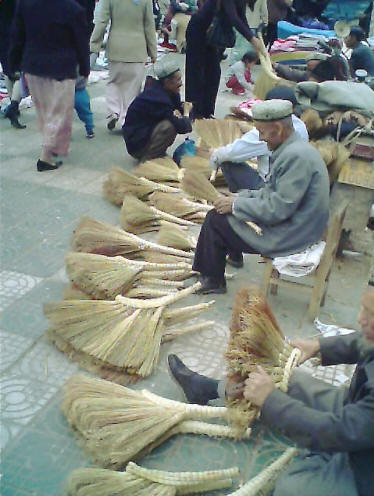
KASHGAR: The whisk-broom sellers arranging their wares.
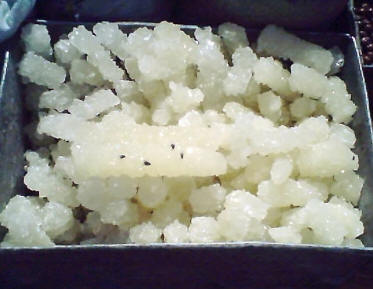
KASHGAR: A box of crystallized sugar being offered for sale in the Grand
International Bazaar. It must be sweet; just look at all the flies helping
themselves.
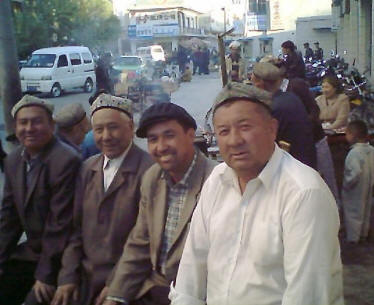
KASHGAR: One evening outside my first hotel, the watermelon seller (second
from right) spotted me and motioned for me to come over and sit a spell. His
buddies all gathered round and we had an interesting "conversation" about
our ages. At 45 he is the youngest of our group. At 70 I have outlived the
others by at least ten years! The incredulous guy on the end demanded proof
and I showed them my passport. The eldest is held in the highest regard in
the Uyghur communities. At my age I'm practically a saint!
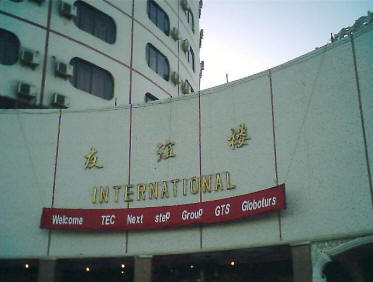
KASHGAR: Exterior of the newer Qinibagh Hotel building where I lived for
most of my stay. It is a three star hotel and I paid 300 Yuan per night,
about $37.

KASHGAR: Exterior of the newer Qinibagh Hotel building where I lived for
most of my stay. It is a three star hotel and I paid 300 Yuan per night,
about $37. The former British Embassy now is part of the hotel complex.
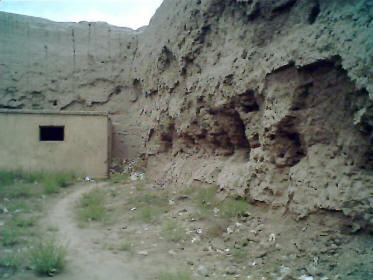
KASHGAR: The ancient wall seems to have become an impediment to modern
construction. Buildings butt up against it. Where the wall interferes with a
building it is chopped away.

KASHGAR: The ancient wall seems to have become an impediment to modern
construction. Buildings butt up against it. Where the wall interferes with a
building it is chopped away.

KASHGAR: The ancient wall seems to have become an obstacle to progress. So,
the old must make way for the new. What a shame.
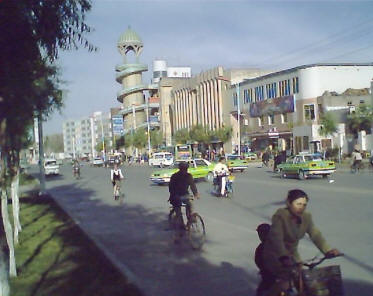
KASHGAR: Looking north along Jiefang Road toward the junction with Seman
Road.
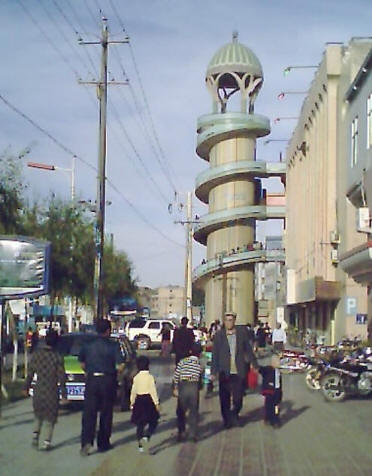
KASHGAR: The interesting building with the spiral staircase is located at
the junction of Jiefang Road and Seman Road.

KASHGAR: One of the neighborhood mosques in the old Uyghur section.
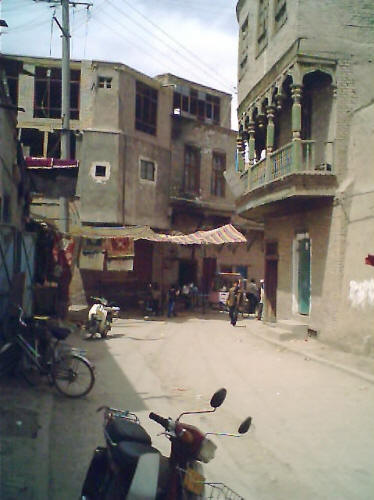
KASHGAR: Looking down one of the residential streets in the old Uyghur
section.
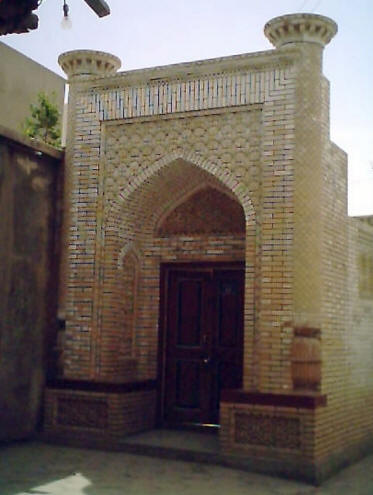
KASHGAR: One of the neighborhood mosques scattered throughout the old Uyghur
section of town.
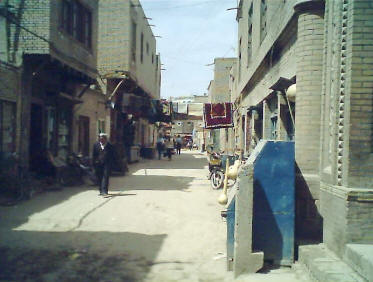
KASHGAR: Looking down one of the residential streets in the old Uyghur
section.

KASHGAR: Looking down one of the residential streets near the Apak Hoja Tomb
monument.
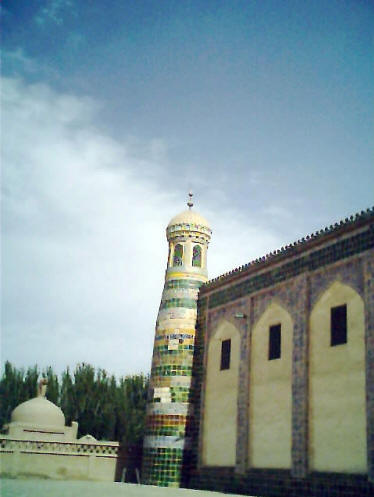
KASHGAR: One of the four towers at the Apak Hoja Tomb monument.

KASHGAR: Around the quiet grounds at the Apak Hoja Tomb monument.
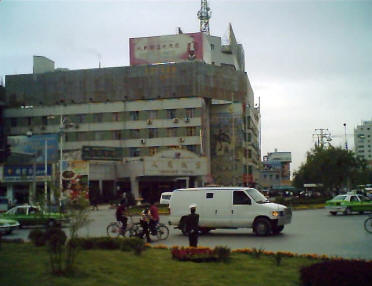
KASHGAR: NE corner of the main intersection at Renmin Road and Jiefang Road;
The People's Hotel in the center of town.
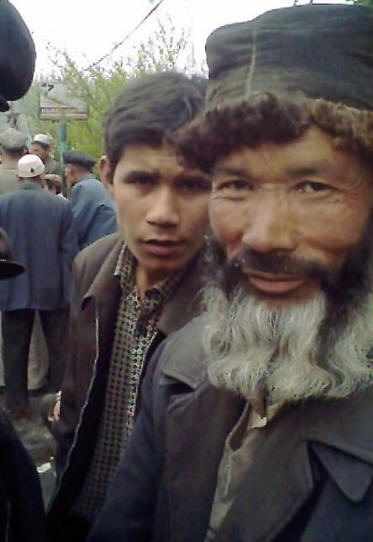
KASHGAR: This old guy figured out my camera and indicated I should take his
picture.
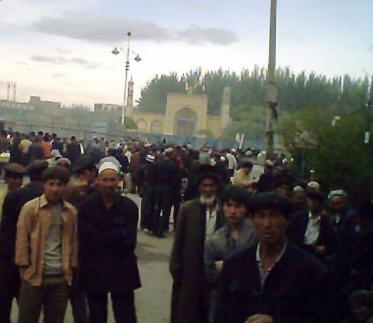
KASHGAR: Throngs of people (mostly men) crowd the market street near the
main mosque.
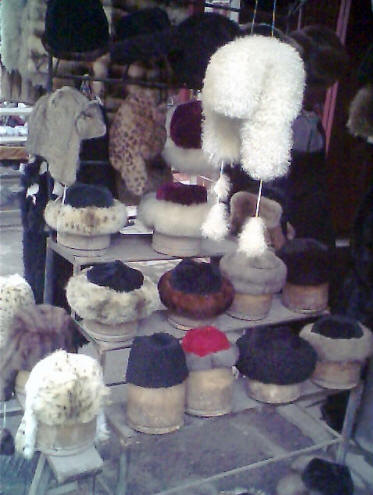
KASHGAR: Hats of all the minorities living in Kashgar. The craftsmanship
impressed me.
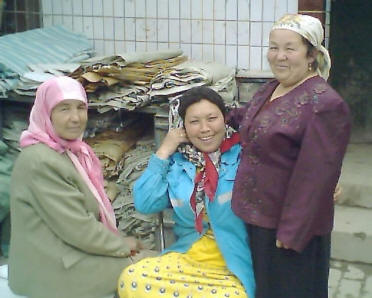
KASHGAR: Mother, daughter and friend. As I approached they were engaged in a
tight embrace and giggled as I approached. I smiled and produced my camera.
They smiled, posed and I snapped.
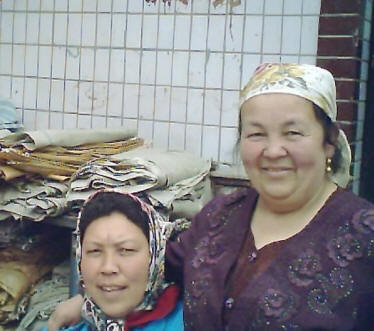
KASHGAR: Mother and daughter now posed for a proper photo. From their
behavior I assume they were celebrating something wonderful which had just
happened to the daughter.
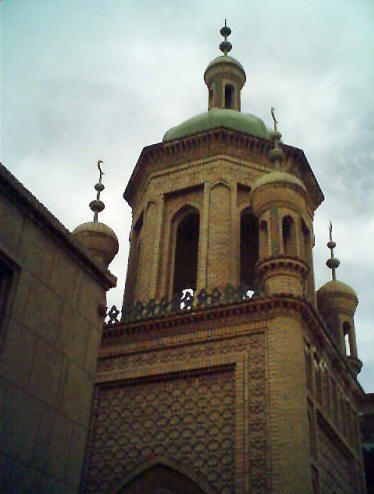
KASHGAR: One of the neighborhood mosques in the old Uyghur sections of town.
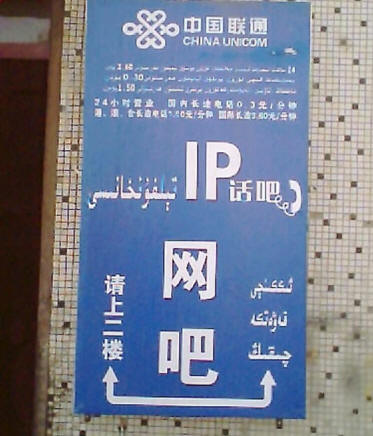
KASHGAR: Two important Chinese characters I have had to learn: these mean
"Wang Ba" or net bar and designate the location of a cybercafé, usually in
an out of the way dingy upstairs room. Some have upwards of a hundred
terminals. Very few people use them to access the Internet. Most are playing
games!

KASHGAR: The other of the pair of lions guarding the entrance to the
Qinibagh Hotel where I stayed most of the time.

KASHGAR: City Square next to People's Park.
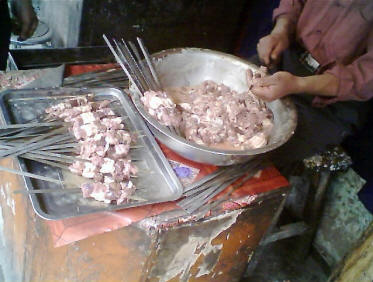
KASHGAR: Street vendor preparing meat for kabobs.
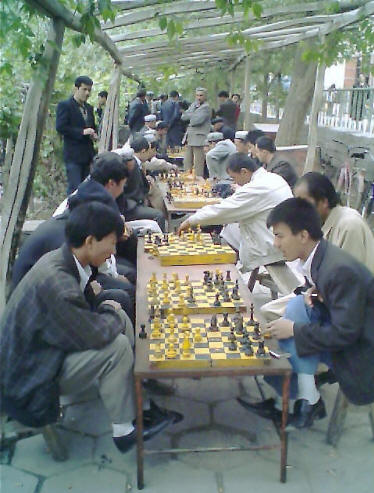
KASHGAR: Chess players. Unlike the players I watched in Urumqi, these guys
are playing by the rules I know.
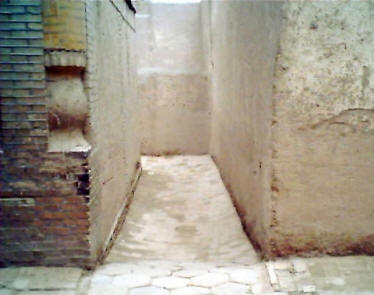
KASHGAR: One of the narrow passageways leading to someone's home in the old
Uyghur section near the city wall ruins.

KASHGAR: Cute babies with a cluster of grandmothers. As I admired the kids
the grandmothers motioned for me to take their pictures.
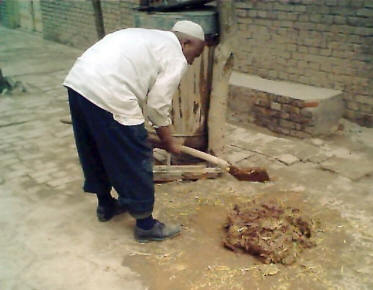
KASHGAR: Man making a batch of mud and straw to patch a leaky roof.
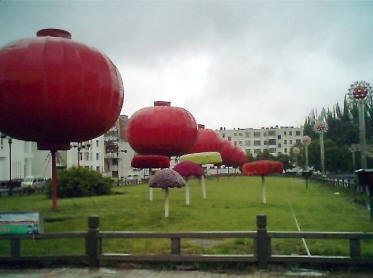
KASHGAR: People's Square looking toward statue of
Mao Zedong.
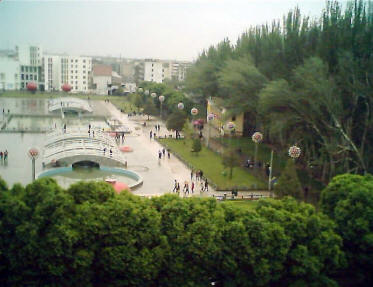
KASHGAR: People's Square looking at the edge that borders on People's Park.
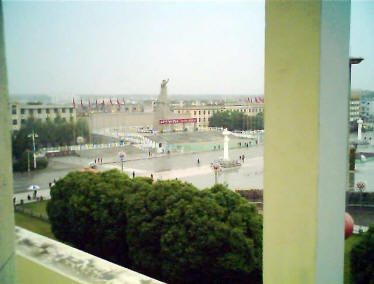
KASHGAR: People's Square looking toward statue of
Mao Zedong as seen from my room in the XXX Hotel where I spent my last
night in Kashgar.
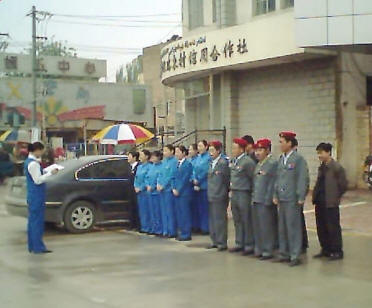
KASHGAR: Staff getting a morning briefing at the XXX hotel where I spent my
last night in Kashgar.
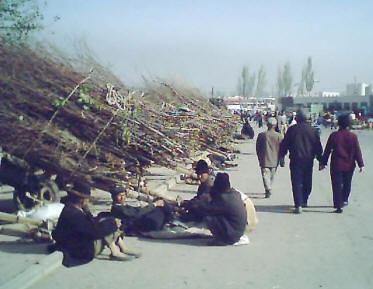
KASHGAR: Along the entry road to the Kashgar Sunday Bazaar I came upon a row
of carts full of tree cuttings.
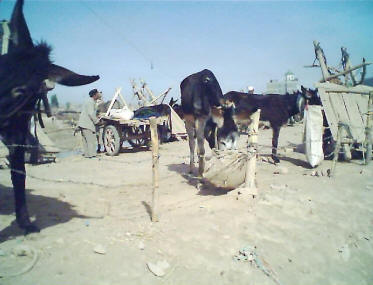
KASHGAR: Entry into the Sunday Bazaar "parking lot". Donkeys and their carts
await the return trip home many hours from now.
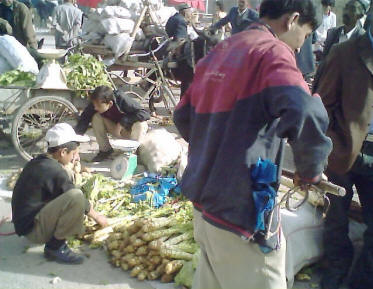
KASHGAR: A vendor arranges his produce for sale at the bazaar.
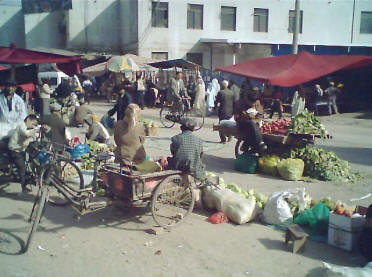
KASHGAR: Sellers open shop in every empty space, including the main roadway!

KASHGAR: As I snapped pictures of hardware for sale an old guy gestured at
his grandchildren and insisted I also take their picture. The kids were not
all that happy about being made the subject of a foreigner's attention.

KASHGAR: Sheep and goat carcasses hang in the same area where brooms and
hardware are being displayed.
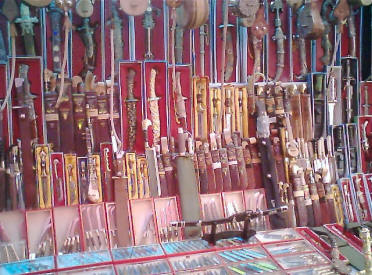
KASHGAR: Beautiful and skillful craftsmanship is evident in the production
of the knives in this display.
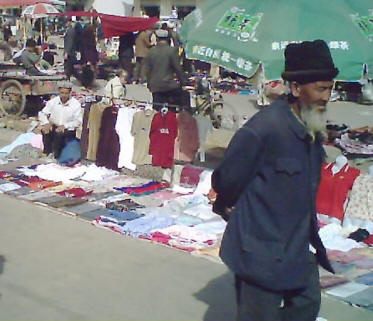
KASHGAR: This slowly walking photogenic old guy almost got past me before my
also slow digital camera cycled ready for a picture.

KASHGAR: Much of the bazaar is open everyday. Only on Sunday do country
people and others come for the "swap meet" with their offerings.
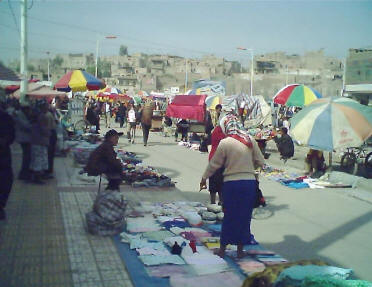
KASHGAR: Another view of the swap meet section of the Sunday Bazaar. Like
their counterparts in the U.S. each seller pays a small fee for the day,
about twelve cents per space.

KASHGAR: Another display of dopas being offered at the Sunday Bazaar.
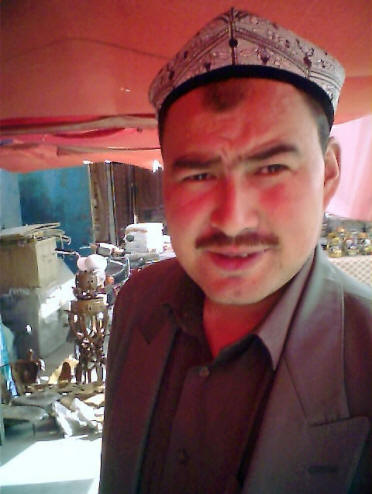
KASHGAR: The hat seller at the Sunday Bazaar.
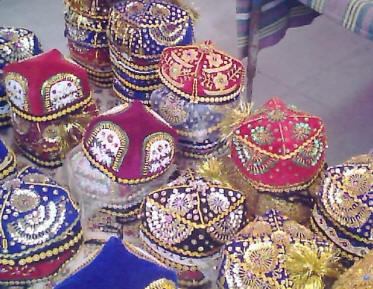
KASHGAR: Some of the hats called Dopas being offered at the Sunday Bazaar.
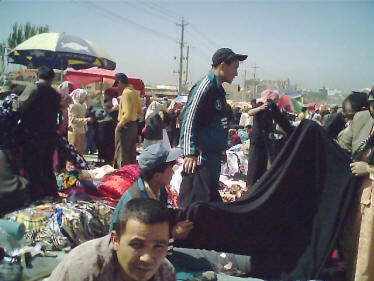
KASHGAR: Thousands of bolts of fabric are offered by countless vendors. The
scene is like a New Year's sale with ladies fighting over choice selections.
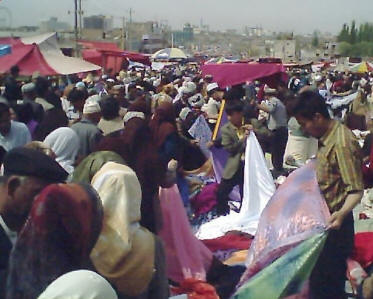
KASHGAR: This guy promotes the virtues of his fabrics as ladies scramble to
the choicest cloths.
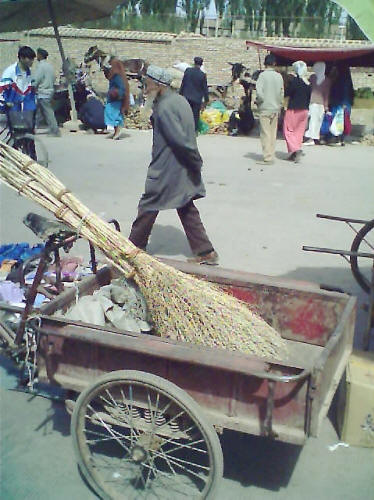
KASHGAR: As I rested in a shady nook out of the surging traffic, commercial
activity continued at the fringes of the market.
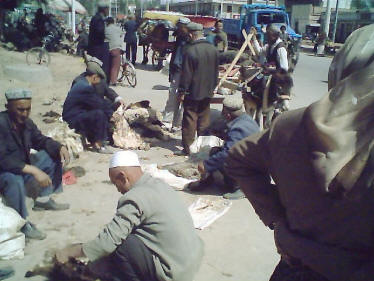
KASHGAR: Sheep skin traders at work near the north entrance to the Sunday
Bazaar. Many of the pelts were freshly removed from their owners.
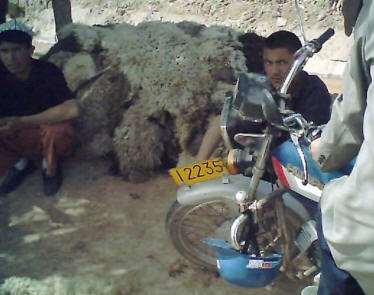
KASHGAR: Another group of sheep skin traders rest near the north entrance to
the Sunday Bazaar. These guys seemed to deal in finished products.
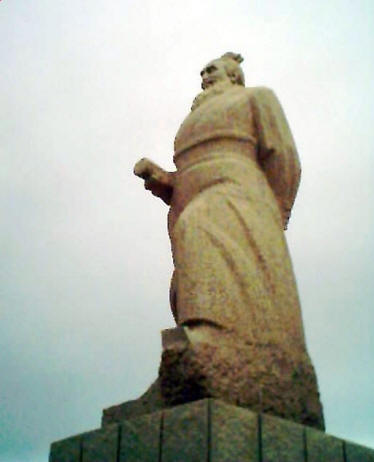
Pantuo City: Statue of Banchao, ruler of Western Han during the 1st century
A.D. The Banchao Memorial Park is in Pantuo City outside of Kashgar.
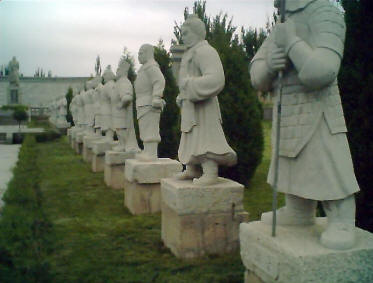
Pantuo City: Right
row of warriors standing to honor the ancient hero, Banchao at the far end.
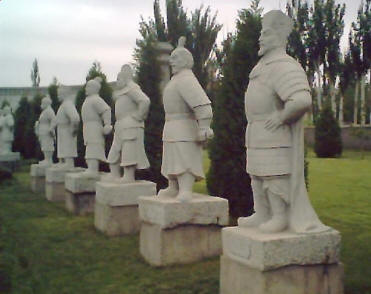
Pantuo City: The Banchao Memorial Park at Pantuo City outside of Kashgar.

Pantuo City: The Banchao Memorial Park at Pantuo City outside of Kashgar.
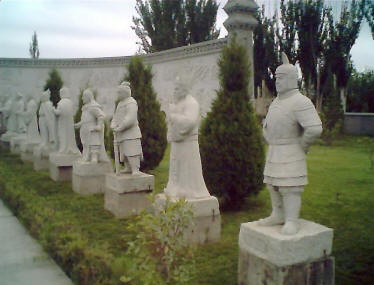
Pantuo City: The Banchao Memorial Park at Pantuo City outside of Kashgar.
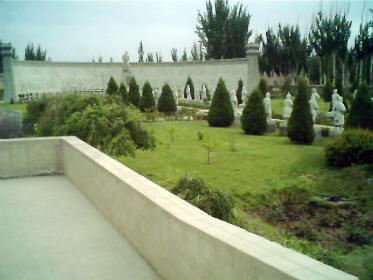
Pantuo City: The Banchao Memorial Park at Pantuo City outside of Kashgar.

Pantuo City: The Banchao Memorial Park at Pantuo City outside of Kashgar.
Bas-relief mural around the statue of Banchao. 7
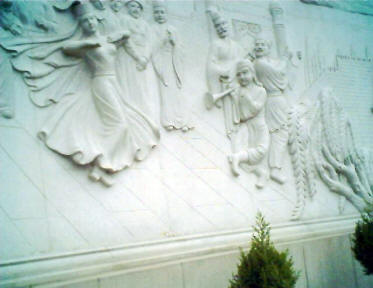
Pantuo City: The Banchao Memorial Park at Pantuo City outside of Kashgar.
Bas-relief mural around the statue of Banchao. 9
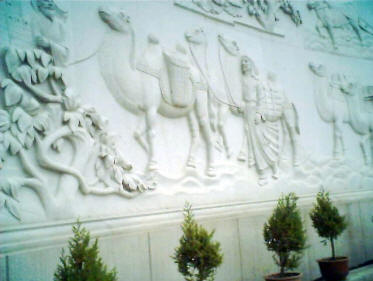
Pantuo City: The Banchao Memorial Park at Pantuo City outside of Kashgar.
Bas-relief mural around the statue of Banchao. 11
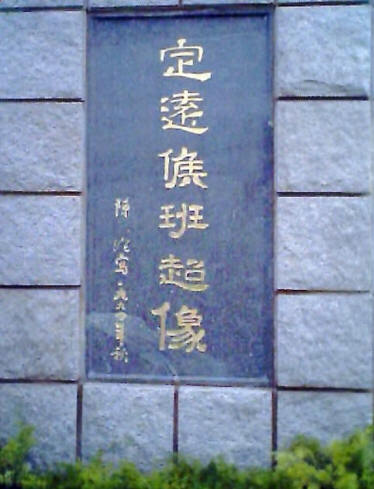
Pantuo City: The Banchao Memorial Park at Pantuo City outside of Kashgar. |



























































































































































































